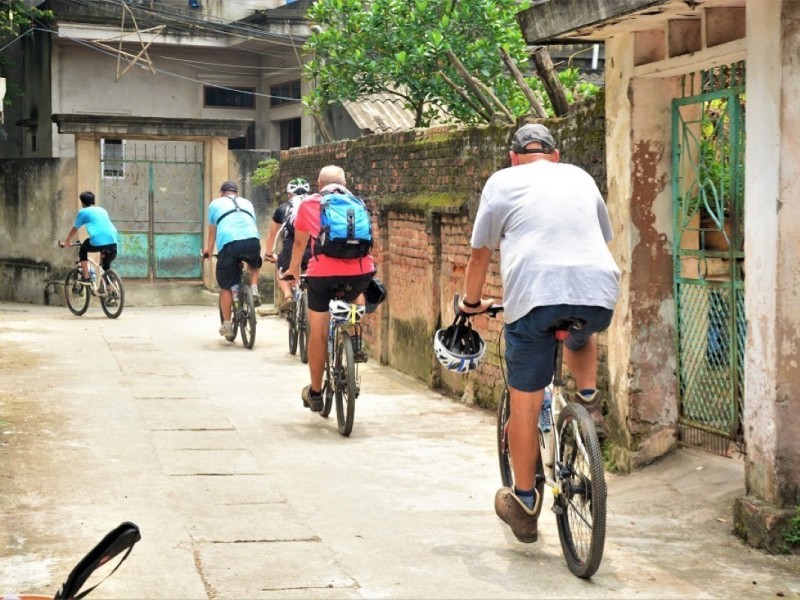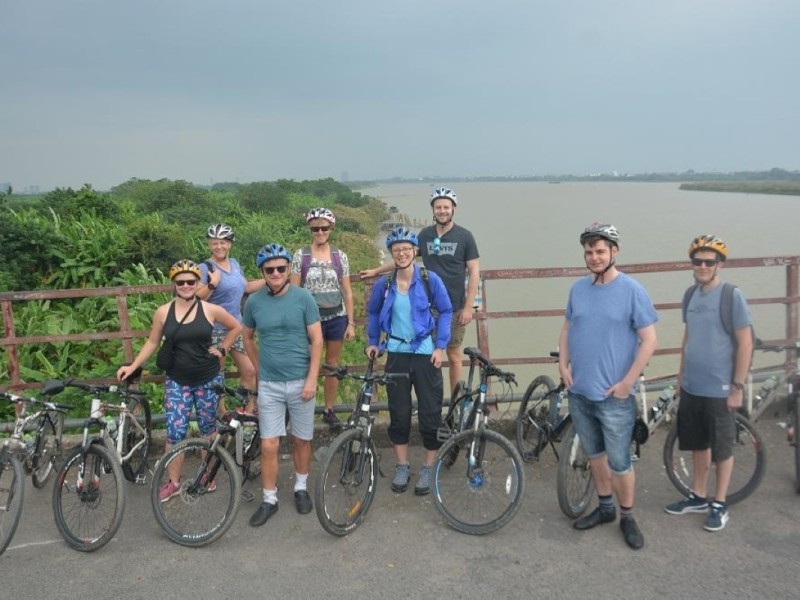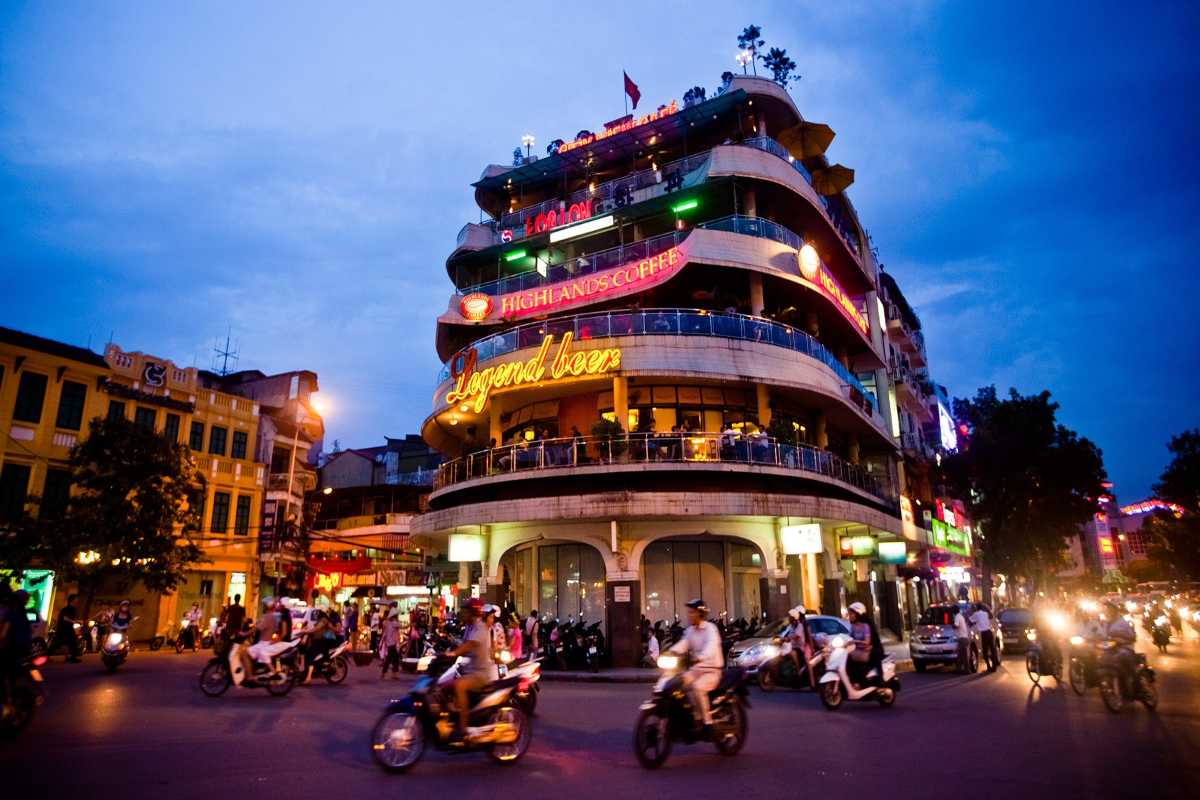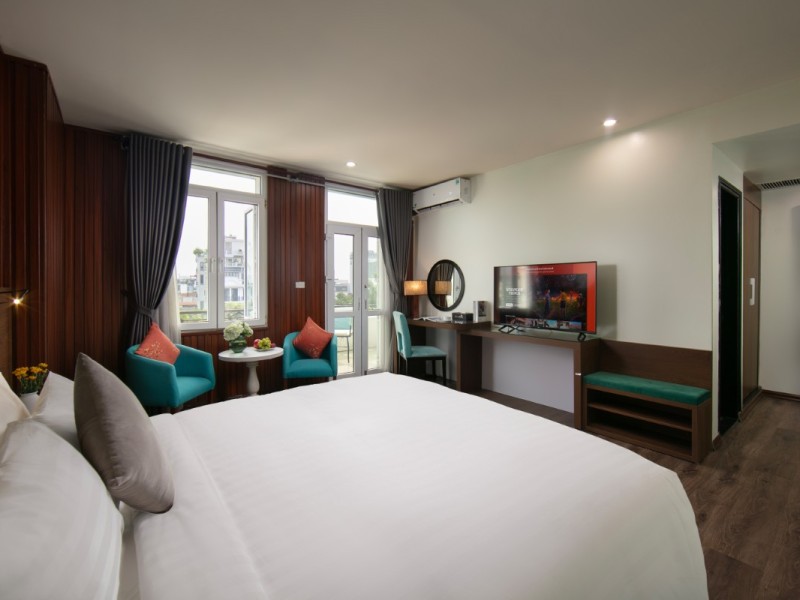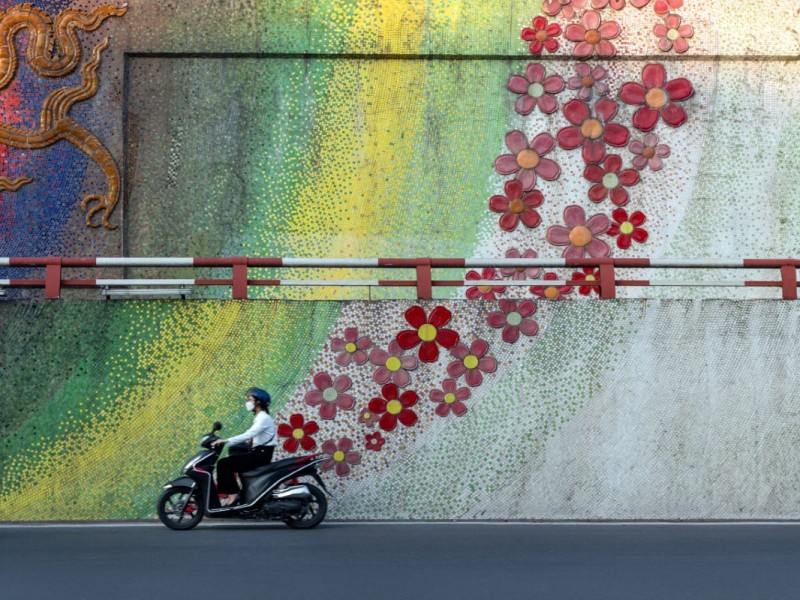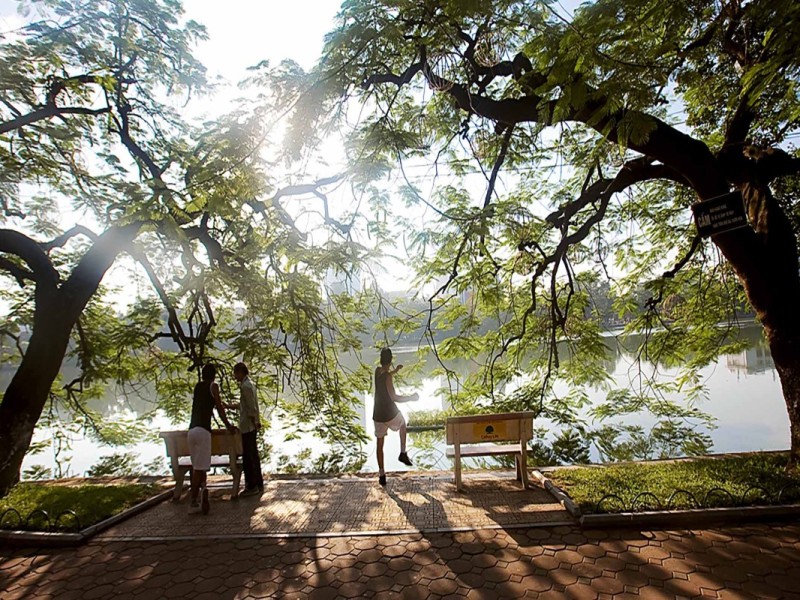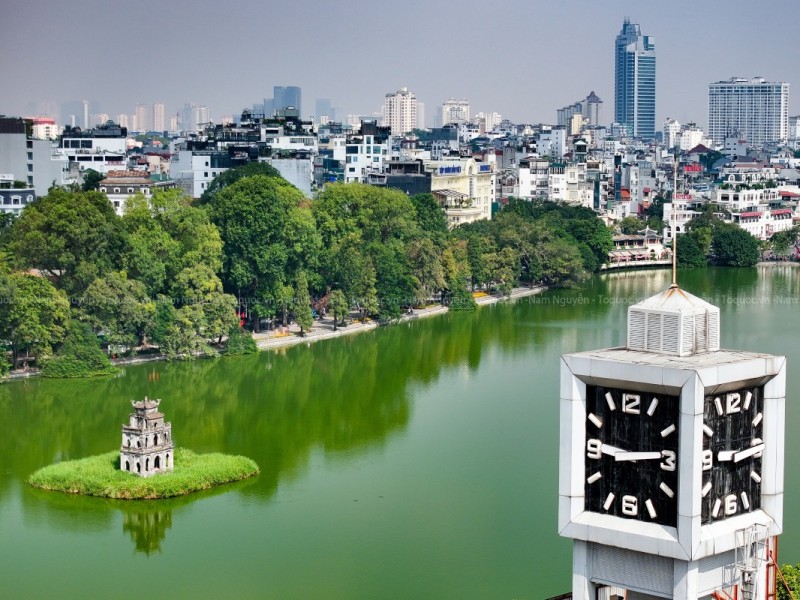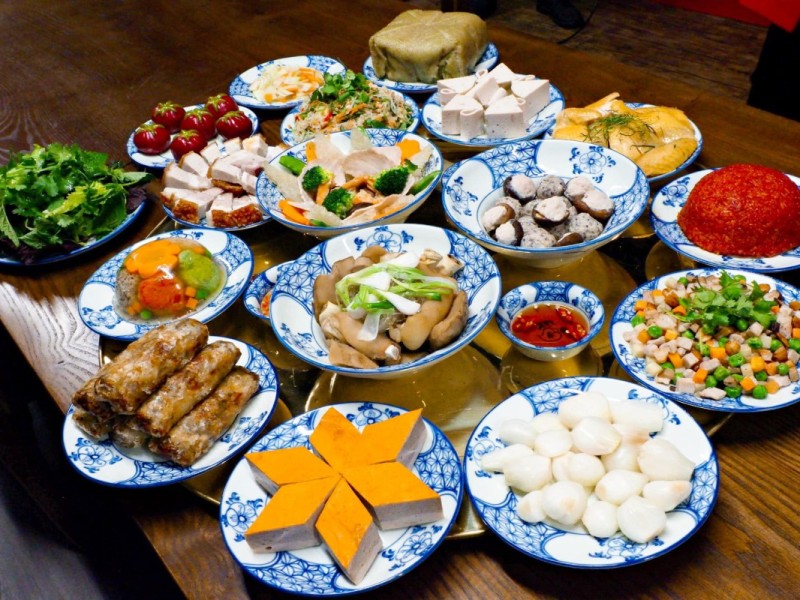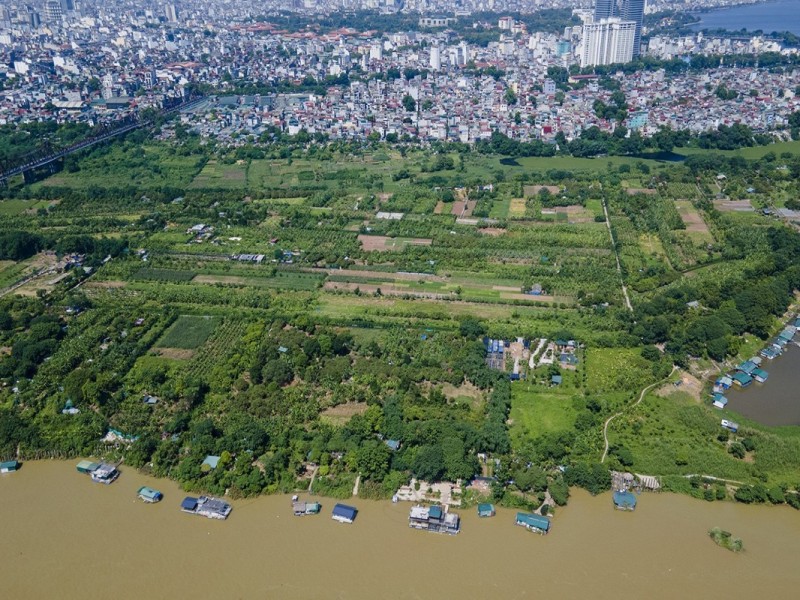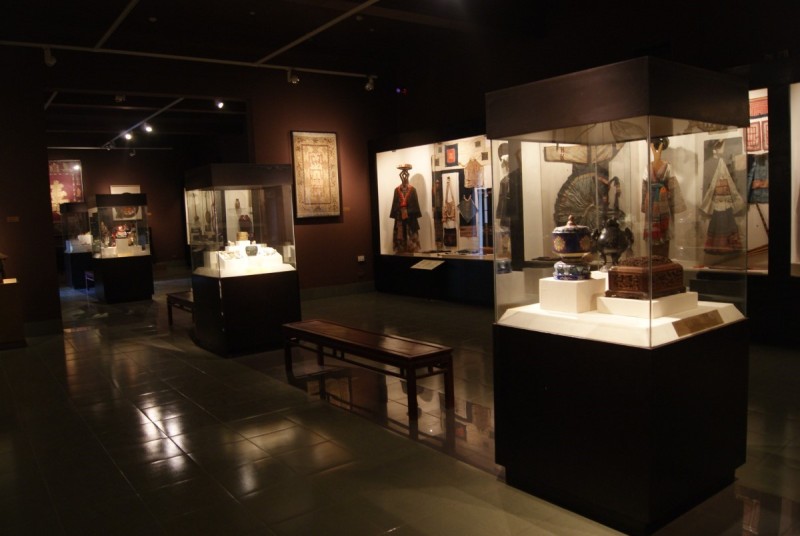Hanoi Train Street: Complete Travel Guide with Tips & Things to Do
Hanoi Train Street is a vibrant urban attraction where trains pass closely through a lively residential neighborhood in Hanoi. Visitors can enjoy unique street views, local cafes, and authentic Vietnamese culture, making it a memorable experience that combines history, daily life, and photography opportunities.
Introduction to Hanoi Train Street
Hanoi Train Street is a fascinating urban attraction that captures the imagination of travelers with its unique blend of bustling street life and active train tracks running just inches from homes and cafes. Located in the heart of Hanoi, this narrow passage offers visitors a glimpse into a vibrant local community where daily life unfolds around the railway. The street’s distinctive charm lies in this rare coexistence of traditional urban culture and the rhythm of passing trains, creating an immersive experience unlike any other.
As you explore Hanoi Train Street, you will witness an authentic fusion of street culture and the close-knit spirit of a community living in harmony with the trains. From colorful shop fronts to residents’ homes extending right onto the tracks, this is a vivid example of an urban environment shaped by history and adaptation. The colonial railway legacy is still palpable here, adding a rich historical backdrop to this living neighborhood.
Visiting Hanoi Train Street means stepping into a dynamic world where every train passage is a moment of collective anticipation and local vibrancy. Plan your visit to Hanoi Train Street and immerse yourself in an unforgettable urban adventure that captures the essence of Vietnam’s capital.
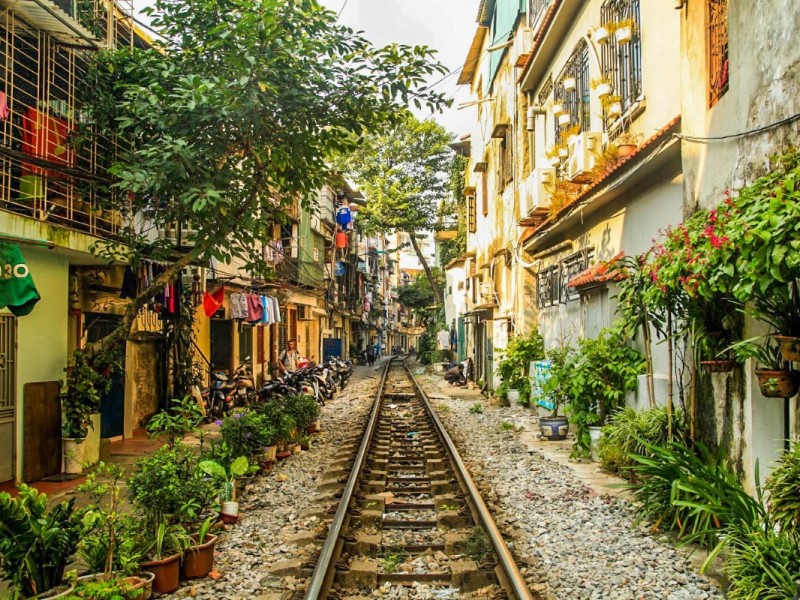
Overview of the Attraction
The Hanoi Train Street offers a rare glimpse into an extraordinary urban environment where trains thunder past just centimeters from residential doorways and bustling cafes. This living community thrives alongside the railway, blending active train tracks with everyday local life. Walking through the narrow street, you’ll notice the vibrant street life—children playing, vendors selling snacks, and residents going about their routines—framed by the looming presence of the tracks.
The proximity of trains to homes creates a surreal and intimate experience unlike anything found elsewhere, drawing photographers, culture seekers, and curious travelers alike. This active railway, still used daily, pulses through the heart of Hanoi, making the street a captivating showcase of resilience and urban vibrancy.
Discover the unique atmosphere of Hanoi Train Street and witness how the local community seamlessly integrates the railway into their daily lives. Explore the blend of sounds, sights, and smells that define this exceptional neighborhood. Don’t miss the chance to experience this authentic slice of Hanoi.
Plan your exploration of Hanoi Train Street today and capture its unforgettable charm firsthand.
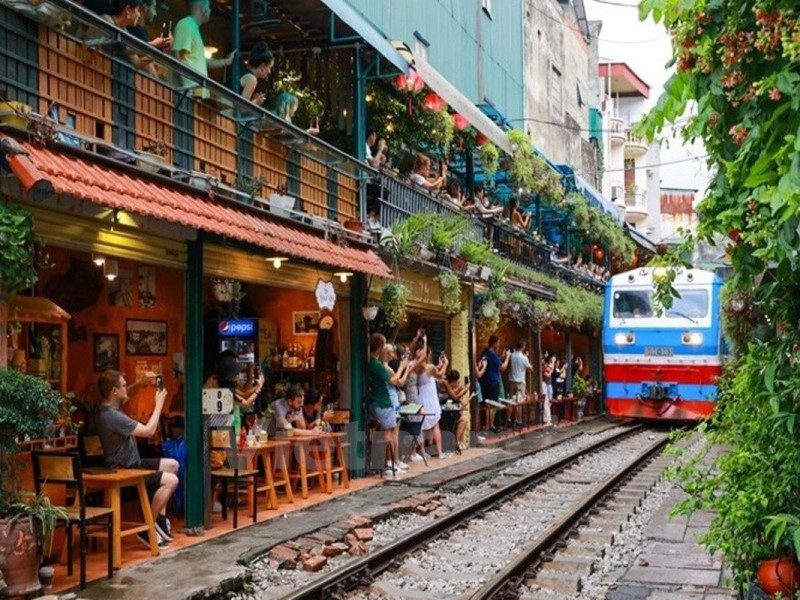
Historical and Cultural Significance
Understanding the history behind Hanoi Train Street Vietnam enriches your visit by connecting you to its deep roots in the city’s evolution. The railway line was constructed during the French colonial era, serving as a vital transportation route that shaped Hanoi’s urban growth. This historic line wove through the fabric of the city, bringing industry and commerce while influencing the layout of neighborhoods along its path.
Today, the street stands as a living monument to that colonial past, reflecting both the changes and continuities in urban life. The railway’s presence influenced how residents adapted their homes and lifestyles to coexist with the frequent passage of trains. This unique urban development tells a story of resilience and cultural vibrancy that continues to define the area.
By learning about the colonial railway history and the urban dynamics along the tracks, you gain insight into how Hanoi Train Street became a distinctive symbol of Vietnam’s capital. Appreciate the layers of history that shape this bustling street and how the community spirit endures amidst changing times.
Experience the legacy of Hanoi Train Street Vietnam on your visit and connect with its rich cultural tapestry.
Origins of the Railway Line and Colonial Influence
The railway line running through Hanoi Train Street traces back to the French colonial era, a time when infrastructure projects reshaped the city.
- French colonial era: The railway was built in the late 19th century as part of the colonial administration’s modernization efforts.
- Railway construction: Designed to connect key economic hubs, the line cut through dense urban neighborhoods.
- Hanoi urban landscape: The railway’s presence influenced how the city expanded, forcing residents to adapt their homes to the tracks’ course.
- Colonial influence: Architecture and urban planning during this period left lasting marks visible in the area surrounding the train street.
These origins explain the close relationship between the railway and urban life that still defines Hanoi Train Street today.
Respect the historical significance when visiting Hanoi Train Street and consider the legacy embedded in its tracks.
Urban Life and Community Dynamics Along the Tracks
Life on Hanoi Train Street is a compelling story of human adaptation and community resilience.
- Local community spirit: Residents have developed a unique culture centered around the railway’s presence.
- Residential proximity: Homes and businesses are built mere inches from the tracks, requiring careful coexistence.
- Adaptation: Daily routines adjust to the train schedule, with families clearing paths minutes before trains pass.
- Street culture: Vibrant street life thrives, blending commerce, social interaction, and tradition.
- Safety practices: The community’s informal rules ensure everyone’s wellbeing while maintaining daily activities.
This close-knit way of life offers visitors an intimate view of urban resilience and vibrant street culture.
Engage respectfully with the local community during your visit to Hanoi Train Street to truly appreciate their way of life.
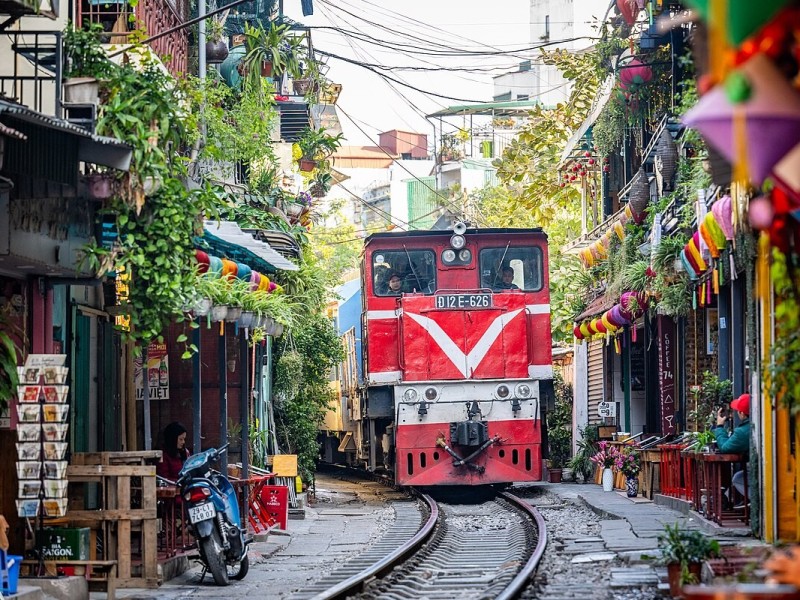
Why Hanoi Train Street is Unique and Popular Among Travelers
Hanoi Train Street captivates visitors with its extraordinary urban setting, where trains pass just inches away from residential homes near trains and bustling local cafes. This rare proximity creates a surreal experience, blending the rhythms of everyday life with the powerful presence of passing trains. Unlike typical tourist attractions, this unique urban attraction offers an intimate view of train proximity that feels both thrilling and authentic.
Travelers are drawn to this site not only for the unusual closeness of trains but also for the vibrant street culture that surrounds the tracks. The street buzzes with energy, combining traditional lifestyles with the constant movement of rail traffic. This distinctive combination makes Hanoi Train Street a must-visit spot, appealing to a wide range of tourists eager to witness something truly different.
Discover why Hanoi Train Street continues to charm photographers, culture lovers, and adventure seekers alike by experiencing its captivating blend of history, community, and dynamic urban life firsthand.
Plan your visit to Hanoi Train Street to see why it remains one of Hanoi’s most talked-about and beloved attractions.
Proximity of Trains to Residential Homes and Cafes
One of the most fascinating aspects of Hanoi Train Street is how the train tracks run remarkably close to residential closeness and local businesses. Homes and urban train route paths intertwine tightly, forcing residents to adapt their daily routines around train schedules.
Local cafes sit right alongside the tracks, offering patrons a front-row seat to the passing trains. This rare setting allows visitors to feel the intensity of the train’s approach while enjoying a coffee or snack in cozy, vibrant spaces.
The remarkable closeness is both thrilling and respectful, showcasing a community that has embraced the railway as part of its unique identity.
Explore these intimate spaces and see how the fusion of life and transit creates an unforgettable atmosphere on Hanoi Train Street.
Visual and Experiential Appeal for Photographers and Tourists
The aesthetic charm of Hanoi Train Street makes it a hotspot for photographers and tourists seeking unique visuals and experiences.
- Photography Hanoi Train Street: Capture the dramatic contrast between the old architecture and the fast-moving trains.
- Vibrant street life: Document locals’ daily activities framed by the railway’s proximity.
- Dramatic juxtaposition: Use angles that highlight the tension between the urban environment and the train’s path.
- Lighting conditions: Take advantage of natural light during golden hours for atmospheric shots.
- Timing tips: Visit during quieter times to avoid crowds and get unobstructed views.
These features combine to create a sensory-rich visit that goes beyond sightseeing—inviting you to engage creatively with the scene.
Bring your camera and immerse yourself in the captivating street life and striking contrasts of Hanoi Train Street.
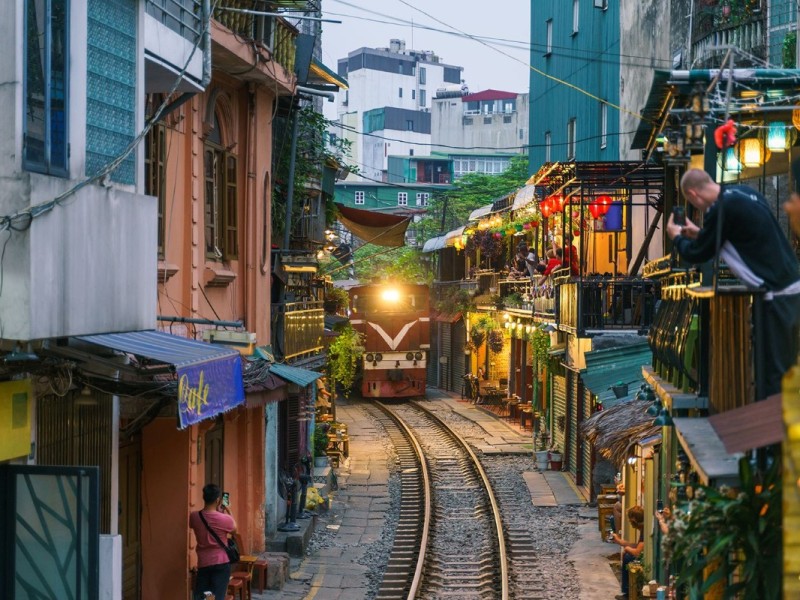
Planning Your Visit to Hanoi Train Street
Planning your visit to Hanoi Train Street is essential to ensure a smooth and enjoyable experience. This section provides clear, actionable information to help you navigate transportation, timing, and logistics so you can focus on soaking in the unique atmosphere of this vibrant urban attraction.
Knowing how to get to Hanoi Train Street, the best times to visit, and train schedules will save you time and help you avoid crowds. Whether you prefer walking through the charming Old Quarter Hanoi, taking public transport, or using taxi and ride-hailing services, this guide offers practical advice tailored for every traveler.
Prepare for seasonal weather variations to make the most of your visit. Plan your trip with confidence and enjoy the authentic energy of Hanoi Train Street.
Make sure to check updated local conditions before you go and plan your visit to Hanoi Train Street for a memorable and hassle-free experience.
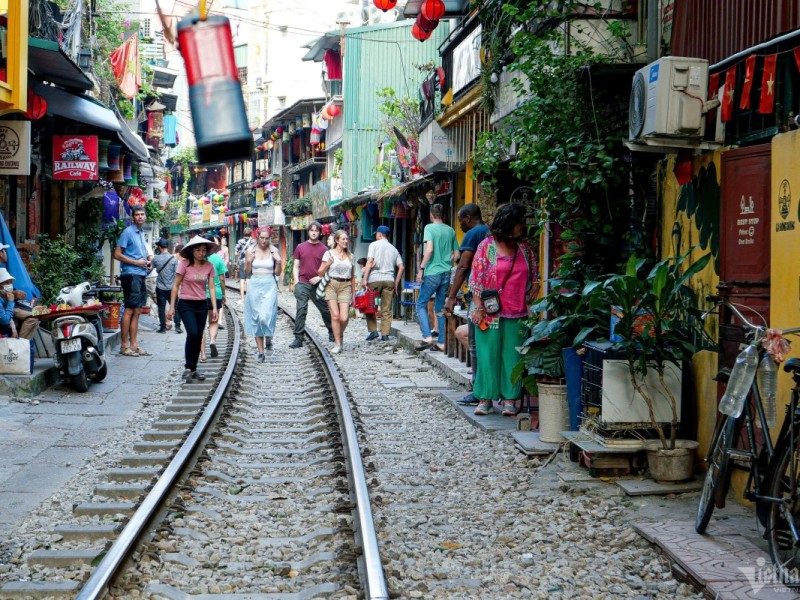
Location and How to Get There
Getting to Hanoi Train Street is straightforward once you know your options. This guide will help you understand the best routes and transportation methods from key points in the city.
If you’re wondering how to get to Hanoi Train Street, here are clear directions and transport tips to ensure you arrive without stress.
Using public transportation Hanoi options or reliable taxi services Hanoi can make your journey easier and budget-friendly.
Follow these tips to navigate the city confidently and arrive ready to explore.
Plan your route early to enjoy the vibrant sights and sounds upon arrival at Hanoi Train Street.
Detailed Directions from Hanoi Old Quarter
To walk from the heart of the Old Quarter Hanoi to Hanoi Train Street, follow these steps:
- Start at Hoan Kiem Lake and head east along Le Duan Street.
- Continue straight for approximately 15 minutes (about 1.2 kilometers).
- Look for the railway tracks running parallel to the street; the entrance to the train street is near Ngo 224 Le Duan.
- Follow the narrow alleys leading to the tracks, marked by local cafes and small shops.
- Use landmarks like Pham Dinh Ho Street to guide your way.
This walking route offers a scenic stroll through lively neighborhoods filled with street vendors and local life.
Wear comfortable shoes and allow 20-30 minutes to reach Hanoi Train Street at a relaxed pace.
Get ready to immerse yourself in the vibrant urban culture just steps from the city center.
Public Transportation Options and Routes
For budget travelers, using public transportation is a smart way to reach Hanoi Train Street. Consider these bus options:
- Bus 9: Stops near Le Duan Street, close to the train tracks.
- Bus 22: Serves routes connecting the Old Quarter Hanoi to surrounding districts.
- Bus 34: Passes through central Hanoi, with stops near key tourist areas.
- Use local apps like Moovit or Google Maps for real-time bus schedules and route planning.
Public transport is affordable and gives you a chance to experience everyday Hanoi life.
Plan your trip using public buses for an authentic and economical route to Hanoi Train Street.
Taxi and Ride-Hailing Services
If convenience is your priority, consider using taxi or ride-hailing services in Hanoi:
- Use Grab Hanoi, a popular app offering fair prices and reliable rides.
- Official taxis such as Mai Linh and Vinasun are reputable choices.
- Avoid unmarked cabs or drivers who refuse to use the meter to prevent scams.
- Confirm your fare before starting the trip and use apps to estimate prices.
- Ride-hailing apps often provide driver and vehicle information for safety.
Choosing trusted transport services helps you reach Hanoi Train Street comfortably and securely.
Book your ride ahead and enjoy hassle-free transportation in Hanoi.
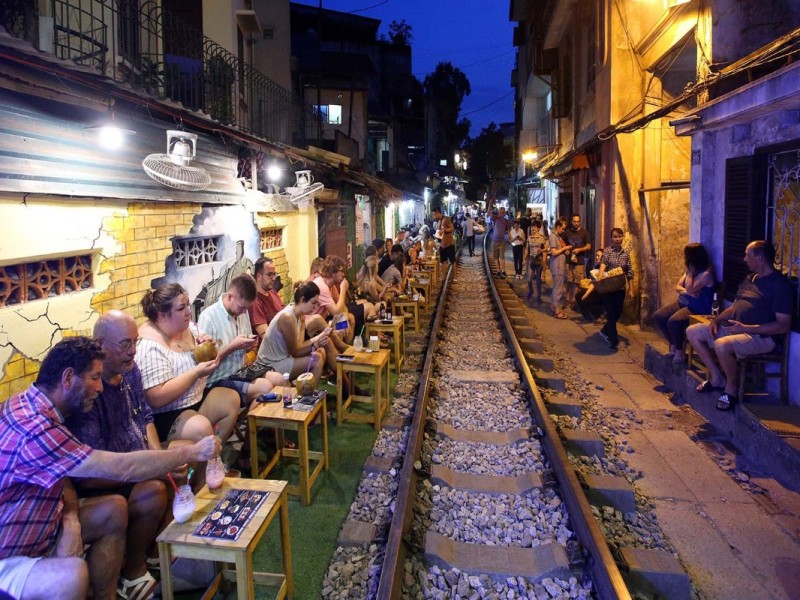
Best Time and Days to Visit
Choosing the best time to visit Hanoi Train Street can greatly enhance your experience. The street’s charm peaks during specific hours when trains pass and the crowd size varies throughout the week. Understanding the train schedule Hanoi Train Street helps you plan your visit to witness the trains safely and enjoy the vibrant atmosphere.
Generally, trains run several times a day, with peak viewing times in the morning and late afternoon. Weekdays tend to be less crowded than weekends, offering a more intimate experience. Additionally, being mindful of seasonal weather Hanoi ensures you dress comfortably and prepare for changing conditions.
Plan your trip around these factors to fully enjoy the dynamic and captivating energy of Hanoi Train Street.
Train Passing Schedules and Peak Viewing Times
Trains typically pass through Hanoi Train Street several times daily. While schedules can vary, the most reliable times are:
- Morning: Around 3:30 PM and 7:30 PM
- Afternoon: Between 3:30 PM and 4:30 PM
- Evening: Some trains pass as late as 9:00 PM
Arrive 20 to 30 minutes early to secure a good spot. Weekdays usually have fewer visitors, allowing for easier photography and a calmer atmosphere. Weekends attract larger crowds, so plan accordingly if you prefer less busy times.
Check local sources or ask residents for the most current train schedule Hanoi Train Street.
Seasonal Weather Considerations
Hanoi’s climate varies significantly by season, influencing your visit to Hanoi Train Street:
- Summers (May to September): Hot and humid, with frequent afternoon showers. Wear light, breathable clothing and carry an umbrella.
- Winters (November to February): Cooler and drier, ideal for outdoor activities. Bring a light jacket for the evenings.
- Spring and autumn offer mild temperatures and pleasant conditions for exploring.
Be prepared for weather changes by packing appropriately. Comfortable shoes, sun protection, and hydration are essential year-round.
Understanding seasonal weather Hanoi will help you enjoy Hanoi Train Street comfortably and safely.

Entry Fees and Accessibility
Visiting Hanoi Train Street comes with no official entry fees, making it an accessible attraction for all travelers. However, understanding the area’s safety guidelines and physical accessibility is essential to ensure a smooth visit.
While the street itself is open to the public, respecting Hanoi Train Street safety rules helps protect both visitors and residents. Familiarize yourself with any restrictions and be mindful of your surroundings to enjoy the experience safely.
If you have mobility concerns, be aware that the terrain includes narrow paths and uneven surfaces, which may pose challenges. Planning ahead can make your visit more comfortable.
Stay informed about Hanoi Train Street entry fees and accessibility to prepare well and enjoy your visit without surprises.
Access Regulations and Safety Guidelines
When visiting Hanoi Train Street, please adhere to the following safety and conduct guidelines to respect the community and ensure your well-being:
- Always stay behind safety lines when trains approach.
- Do not step onto or linger on the tracks.
- Follow instructions from local residents and authorities.
- Avoid loud noises or disruptive behavior to respect the neighborhood.
- Do not obstruct cafes or homes along the tracks.
These rules are vital for your safety and help preserve the peaceful coexistence between visitors and residents.
Observing Hanoi Train Street safety rules is essential for a positive and safe experience.
Accessibility for Visitors with Mobility Issues
Travelers with mobility challenges should note that Hanoi Train Street features uneven surfaces and narrow walkways, which can make navigation difficult. Wheelchair users or those with strollers may find access limited in certain areas.
Consider these practical tips:
- Use nearby accessible streets to approach the train street as closely as possible.
- Contact local guides or your accommodation for advice and assistance.
- Wear sturdy, comfortable shoes for better stability.
- Avoid visiting during crowded peak times to reduce congestion.
Planning ahead ensures you can enjoy the unique atmosphere of Hanoi Train Street comfortably and safely.
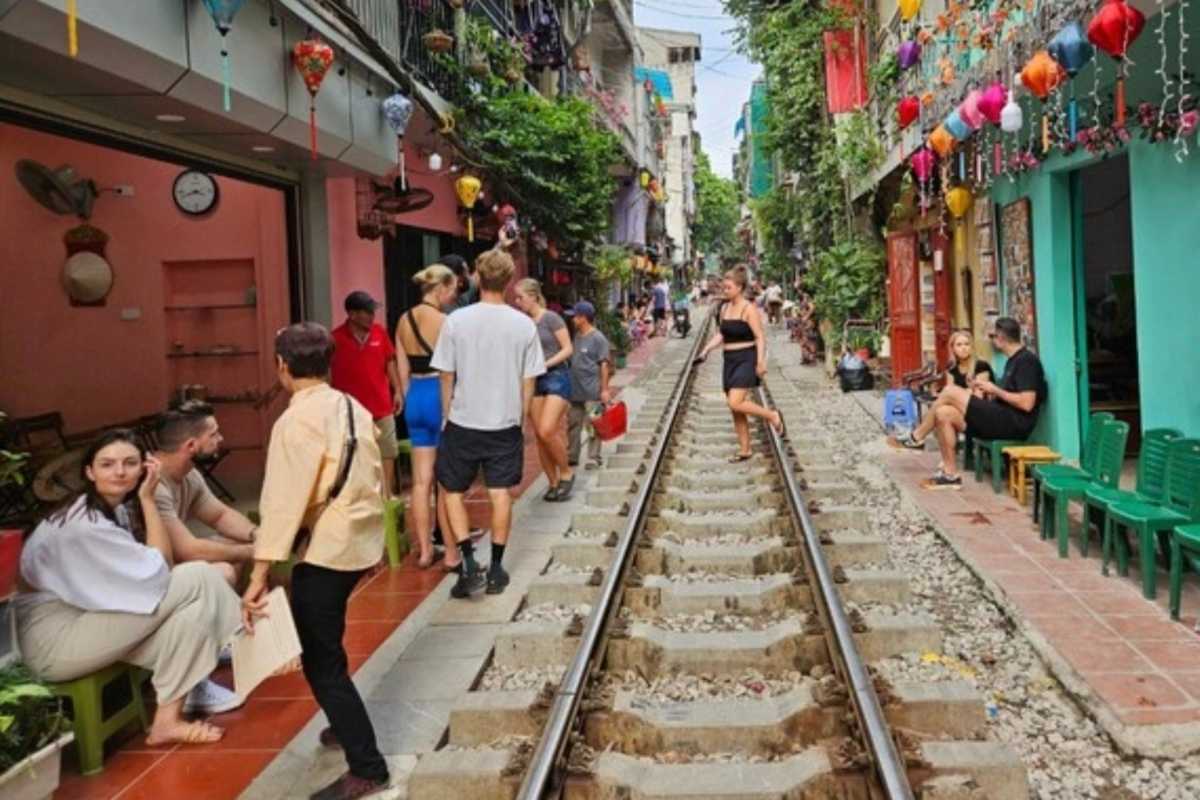
Choosing the Right Cafe for Your Experience
Finding the perfect spot among the many cafes near Hanoi Train Street can greatly enhance your visit. Each cafe offers a unique perspective on the train’s passage, from rooftop terraces with panoramic views to cozy street-level tables where you can feel the train’s close presence.
Some cafes are known for their quiet atmosphere and spacious seating, ideal if you prefer a relaxed experience away from crowds. Others buzz with energy, providing lively social scenes and easy access to local snacks and drinks. Consider the time of day and crowd levels when selecting your cafe to match your mood and preferences.
Whether you want the best photo angles, the freshest Vietnamese coffee, or simply a comfortable seat to watch the trains go by, choosing the right cafe near Hanoi Train Street makes all the difference.
Explore various options and find your ideal cafe to complete your Hanoi Train Street adventure.
Emily's Cafe Quest: Finding the Perfect Viewpoint
The hum of Hanoi’s Old Quarter always sets a particular rhythm in my soul, a chaotic symphony of motorbikes, hawkers' cries, and the distant clang of metal. But on this particular morning, as I navigated the labyrinthine alleys, my ears were tuned for a different sound: the low rumble of a train. My mission? To find the perfect vantage point on the legendary Hanoi Train Street, a place where the ordinary act of sipping coffee becomes an exhilarating dance with an approaching locomotive.
My initial anticipation was a mix of giddy excitement and a touch of trepidation. I’d seen countless photos – people perched inches from speeding steel – and wondered if it was as thrilling, or as terrifying, as it looked. I started my quest on Trần Phú Street, one of the main arteries leading to the more famous sections. The narrow entrance to the train tracks, often guarded by locals or even police, initially felt like trying to sneak into a secret club. But a friendly café owner, seeing my determined expression, waved me in with a warm smile and a gesture towards his small, colorful establishment. "Coffee?" he asked, already placing a tiny plastic stool on the tracks.
The air here was different. Even without a train in sight, the atmosphere crackled with a unique energy. Houses, painted in hues of ochre and jade, clung to the railway line like barnacles to a ship. Laundry hung lazily from windows, just a whisper from the rails. The scent of strong Vietnamese coffee mingled with the earthy dampness of the concrete and the faint, metallic tang of the tracks themselves. I settled onto one of the miniature stools, ordered an iced cà phê sữa đá (Vietnamese iced coffee with condensed milk), and let my eyes trace the path ahead. The sweet, robust flavor of the coffee, icy cold, was a welcome contrast to the humid morning air.
How to get to Hanoi Train Street is fairly straightforward, but finding the sweet spot, the best cafes Hanoi Train Street has to offer, is the real quest. Many online guides point you to sections near Trần Phú and Phùng Hưng streets. What they often don't tell you is that some areas are more regulated than others. The trick is to patronize one of the local cafes; their owners act as unofficial gatekeepers and guides, ensuring you're safely seated when the train approaches. I learned quickly that showing genuine interest in their business makes all the difference.
As the morning wore on, the street began to awaken more fully. Children chased stray chickens between the tracks, their laughter echoing off the close-set walls. Women in conical hats squatted, sorting vegetables for market. This wasn't just a tourist attraction; it was a living, breathing neighborhood. I kept an eye on the clock, mindful of the train schedule Hanoi Train Street operates on. Weekends generally have more trains, with typical times around 9:15 AM and 11:20 AM in the morning, and several in the afternoon and evening. My chosen café owner, a wizened woman with kind eyes, confirmed the next train was due around 11:40 AM. She simply nodded, then returned to meticulously cleaning her small counter, an almost meditative calm about her.
Then it happened. A distant, low rumble, growing steadily louder. The chatter on the street hushed. Café owners, with practiced grace, began pulling in their tiny stools and tables, folding them flat against the walls. A sense of collective anticipation, almost a sacred reverence, descended. The rumble became a roar, and then, a shriek as the train's horn pierced the air. My heart pounded with an unexpected ferocity. The air vibrated, sending tremors through the ground and up through my plastic stool. The train, a long, steel serpent, burst into view, hurtling down the narrow corridor.
It was immense, overwhelming. The sheer force of it, the wind whipping my hair, the scent of hot metal and diesel fumes filling my nostrils. For a few breathtaking seconds, it filled my entire field of vision, a blur of dark green carriages and flashing wheels. I instinctively leaned back, pressing myself against the cafe's wall, marveling at how close it truly was – just inches away. The sounds were deafening: the grinding of steel on steel, the whoosh of air, the blare of the horn. Then, as quickly as it appeared, it was gone, leaving behind a sudden, almost eerie silence, punctuated only by the fading thrum in the air and the rapid, excited chatter of relieved onlookers.
That moment, the raw, unadulterated power of that train rushing past, resonated deeply. It wasn't just a spectacle; it was a visceral reminder of life lived on the edge, of adaptability and resilience. The café owners, as soon as the last carriage vanished, effortlessly pushed their tables back out, normalcy resuming as if an enormous, fleeting ghost had just passed through.
My unique insight? Don't just show up for the train. Go an hour or two early. Settle in at one of the cafes near Hanoi Train Street, truly experience the rhythm of the place before the main event. Watch the locals, sip your coffee slowly, and let the anticipation build organically. This is where the true "experience" of E-E-A-T comes alive, not just in the rush of the train, but in the quiet moments leading up to it.
For actionable takeaways, here's my advice:
- Best time to visit Hanoi Train Street: Aim for the late afternoon or early evening trains (around 3:30 PM, 7:00 PM, or 7:30 PM on weekdays, with more frequent options on weekends). This gives you good light for photos and a lively atmosphere. Always check with a local cafe owner for the most current schedule – it can vary!
- How to interact respectfully: Always enter through a cafe. The owners are often coordinating with each other and the railway staff for safety. Buying a drink (or two!) is your "entrance fee" and supports the local community who share their homes with this unique spectacle.
- What to look out for: When the train is approaching, locals will shout warnings and guide you. Pay attention! Don't try to get that "perfect" selfie on the tracks; it's genuinely dangerous. Stay behind the marked lines or as far back as the cafe owner instructs.
- Specific recommendations: While I didn't catch the name of my exact café, look for ones with a cozy, lived-in feel and owners who greet you warmly. Many best cafes Hanoi Train Street offers are small, family-run establishments. Ask them about the next train time. They often have the most up-to-date information.
Leaving the train street, I carried with me not just the memory of a passing train, but the feeling of having touched something authentic and undeniably Hanoi. It was a perfect blend of thrill, tradition, and warm human connection. If you're ever in Hanoi, make the quest for the perfect viewpoint on Train Street a priority. It's more than just a photo opportunity; it's an immersion into the unexpected heart of the city.
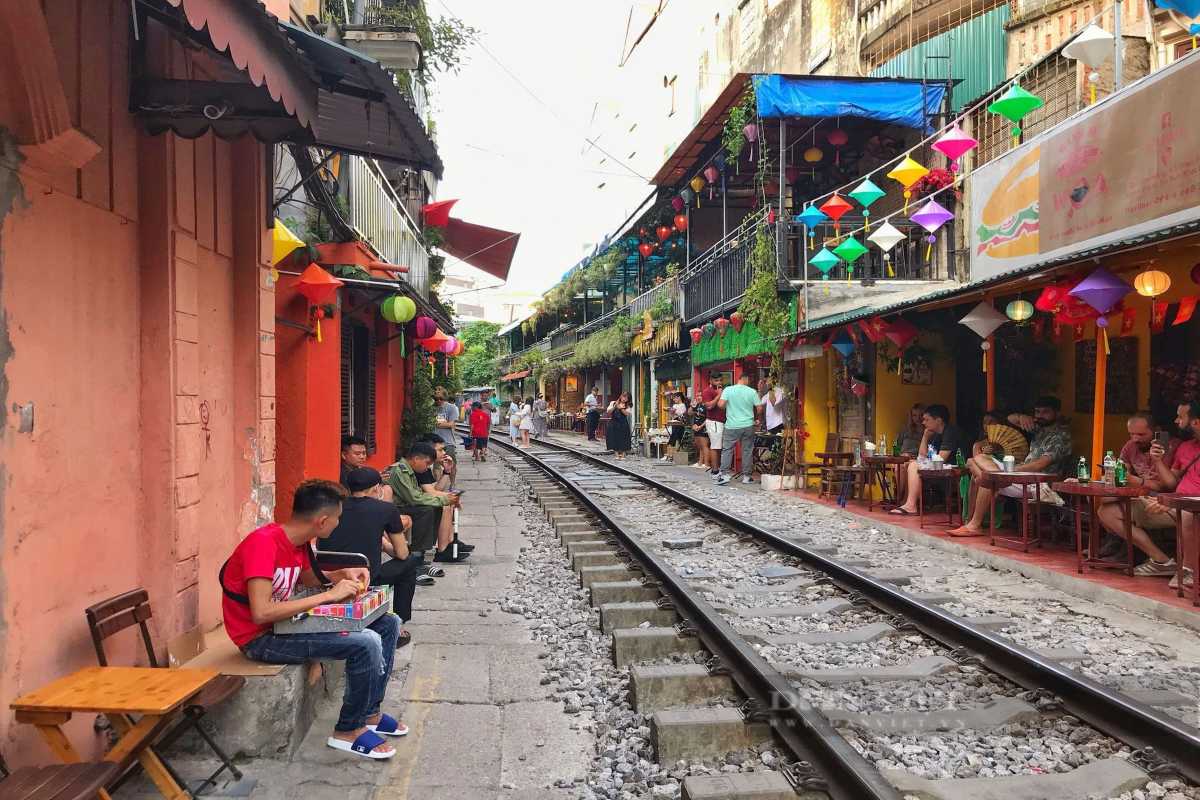
What to Expect at Hanoi Train Street
Visiting Hanoi Train Street offers a truly unique sensory experience where the sights, sounds, and atmosphere come alive as trains pass through a vibrant, living neighborhood. From the build-up to the train’s arrival to the lively cafes lining the tracks, this urban attraction immerses you in the authentic rhythms of daily life in Hanoi.
Prepare to feel the rush of the train speed Hanoi as it barrels close by, witness the friendly interactions with local residents, and enjoy the aroma of freshly brewed Vietnamese coffee in nearby cafes. Understanding the visitor behavior and safety expectations ensures a respectful and memorable visit.
Experience the dynamic blend of excitement and community spirit that makes Hanoi Train Street a must-see destination in Vietnam’s capital.
Plan your visit to Hanoi Train Street and immerse yourself in its captivating street culture.
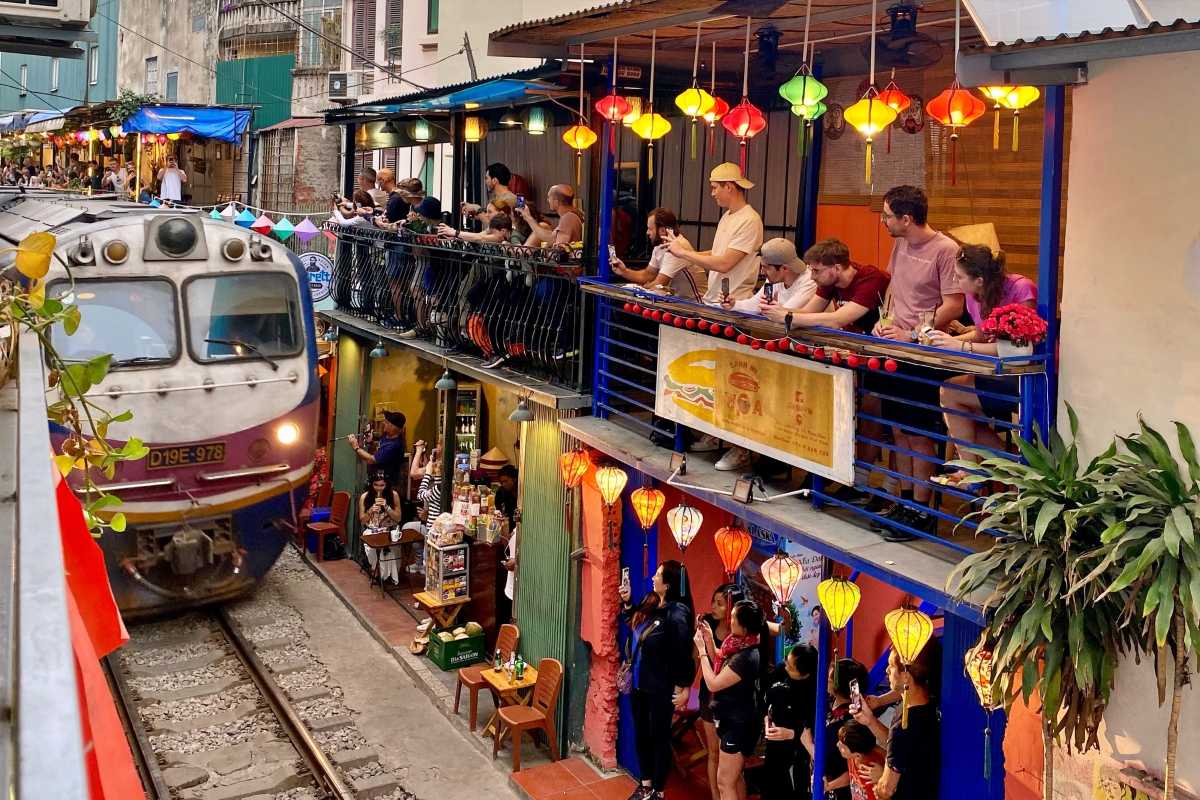
Experiencing the Train Passing
One of the most thrilling moments at Hanoi Train Street is experiencing the train passing up close. The anticipation builds as locals and visitors alike prepare for the train’s approach.
You’ll hear the distant rumble growing louder, feel the ground vibrate with increasing intensity, and then see the train speeding by, often just inches from where you stand. The train speed Hanoi is surprisingly fast, making the event brief but unforgettable.
This sensory experience combines sound, sight, and even the smell of diesel, creating an immersive moment that connects you with the unique life of the street.
Prepare to be captivated by the energy of experiencing the train passing on Hanoi Train Street.
Timing and Duration of the Train Event
To make the most of your visit, here are key details on train timings and duration:
- Trains usually pass 2 to 4 times daily.
- Each passing event lasts approximately 2 to 5 minutes.
- It’s best to arrive 20-30 minutes before scheduled times for a good viewing spot.
- Peak passing times are often in the afternoon and early evening.
Be aware that schedules may change, so check with local sources for up-to-date info.
Understanding the timing helps you plan your visit for the most exciting moments on Hanoi Train Street.
Safety Precautions and Local Etiquette
To ensure a safe and respectful visit to Hanoi Train Street, please follow these guidelines:
- Always step back and stay behind safety lines when trains approach.
- Never stand on or block the tracks.
- Respect local residents by keeping noise levels low.
- Do not disturb homes or businesses along the street.
- Follow instructions from locals or officials promptly.
Adhering to these Hanoi Train Street safety rules protects both you and the community.
Stay alert and considerate to enjoy this remarkable attraction responsibly.
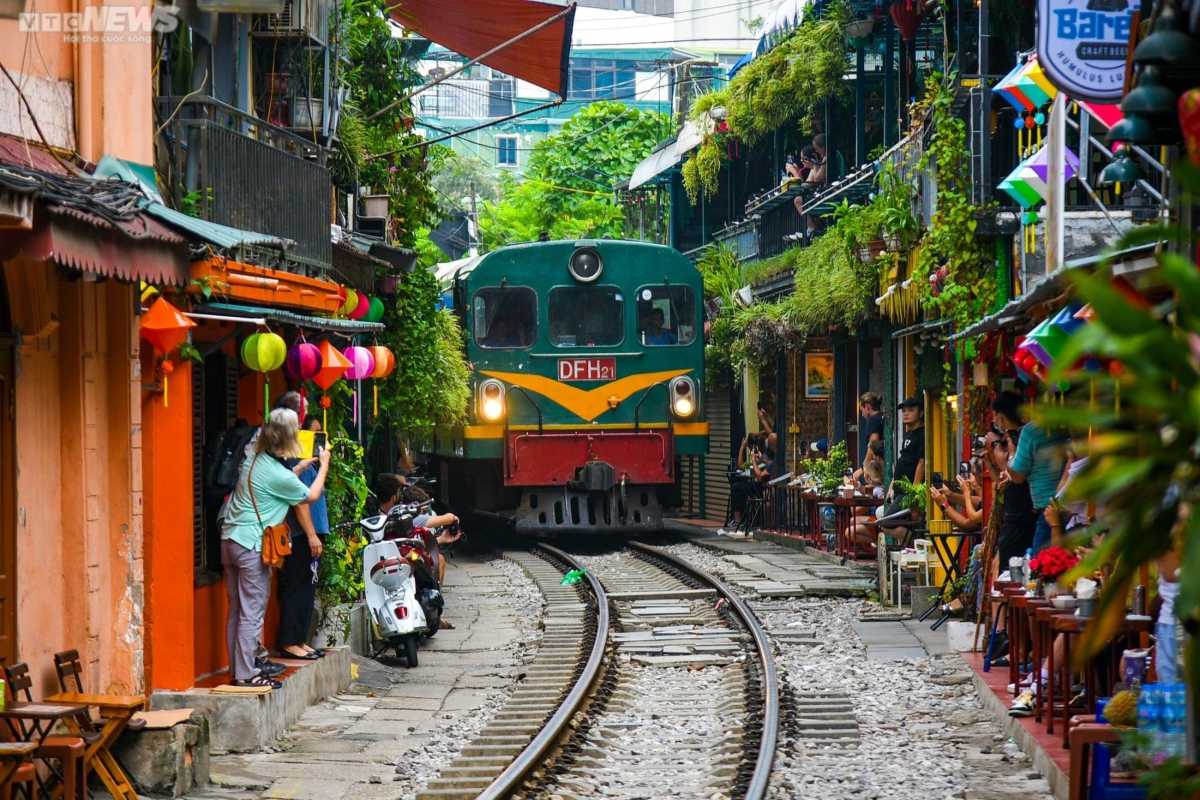
Cafes and Local Businesses Along the Tracks
Exploring the cafes on Hanoi Train Street reveals a vibrant collection of local spots where you can enjoy authentic flavors and unbeatable train views. These businesses blend seamlessly into the lively street culture, offering unique atmospheres that range from quiet, cozy retreats to bustling social hubs.
Visitors often seek out popular cafes Hanoi Train Street for their charming settings and friendly service. Whether you want to savor traditional Vietnamese coffee or relax while watching the trains pass, the diverse cafe options enrich your visit and deepen your connection with the local community.
Choose your favorite cafe and enjoy the dynamic energy of Hanoi Train Street from a comfortable, welcoming spot.
Popular Cafes with Train Views
This section highlights some of the most renowned cafes along Hanoi Train Street that offer spectacular views of passing trains and the lively street below. Each cafe provides a unique atmosphere and vantage point for visitors seeking to combine great drinks with unforgettable sights.
- Cafe Pho Co: Known for its rooftop terrace offering panoramic views of the tracks and vibrant street life.
- Train View Cafe: A favorite for close-up train sightings paired with traditional Vietnamese drinks.
- La Place Cafe: Offers a cozy and quiet ambiance, perfect for savoring rich Vietnamese coffee.
- The Railway Cafe: Popular among photographers due to its excellent vantage points and welcoming environment.
Whether you prefer rooftops or street-level settings, these cafes provide memorable spots to enjoy the essence of Hanoi Train Street. Sampling the ambiance here enhances your overall experience and creates lasting memories.
Plan your visit to these popular cafes Hanoi Train Street to fully appreciate the unique blend of culture and trains.
Menu Highlights and Price Range
Visitors to cafes on Hanoi Train Street can expect a selection of traditional Vietnamese beverages and light snacks that complement the vibrant surroundings. Understanding the menu and prices helps you plan your visit better.
Typical offerings include:
- Vietnamese coffee: Strong, aromatic, and available both hot and iced.
- Fresh fruit juices: Made from seasonal local fruits, refreshing and natural.
- Light snacks: Such as spring rolls, banh mi sandwiches, and other Vietnamese specialties.
- Price range: Most drinks and snacks cost between 20,000 to 50,000 VND (about $1–$2 USD), making these cafes accessible to most travelers.
This combination of authentic flavors and affordable prices adds value to your Hanoi Train Street experience, allowing you to indulge without overspending.
Enjoy the rich tastes of Vietnam as you watch trains roll by and soak in the street’s unique atmosphere.
Interaction with Local Residents and Vendors
Engaging with the local community along Hanoi Train Street brings warmth and authenticity to your visit. This section encourages respectful and meaningful interactions with cafe owners, vendors, and residents.
Many locals welcome friendly greetings and are happy to share stories about life on the street and the passing trains. Using simple Vietnamese phrases or gestures can foster connection and goodwill. These exchanges deepen your understanding of the neighborhood’s culture beyond the surface.
Respectful behavior supports the delicate balance between tourism and daily life, helping preserve the community’s unique spirit.
Take the opportunity to connect genuinely with the people of Hanoi Train Street for a richer and more rewarding travel experience.

Photography and Videography Tips
Capturing the vibrant life of Hanoi Train Street requires some thoughtful planning and technique. This section offers practical photography tips Hanoi Train Street to help you get stunning photos and videos that truly reflect the street’s unique character.
Understanding the best angles Hanoi Train Street and timing your shots to avoid crowds will enhance your experience. Whether you are a casual photographer or a seasoned pro, these tips will improve the quality of your images and make your visit more rewarding.
Use these insights to create memorable visual stories of your journey through this extraordinary urban space.
Best Angles and Equipment Recommendations
Choosing the right angles and equipment is key to capturing the essence of Hanoi Train Street:
- Use wide-angle lenses to capture the narrow street’s depth and the train’s proximity to buildings.
- Zoom lenses help focus on details like residents’ expressions or cafe setups without disturbing them.
- Shoot from rooftops or balconies for panoramic views of the tracks and urban landscape.
- Experiment with low angles to emphasize the train’s speed and closeness.
- Consider natural lighting during golden hours for warm, dramatic effects.
Mastering these techniques will help you produce dynamic and compelling images of this unique destination.
Apply these best angles Hanoi Train Street recommendations to elevate your photography experience.
Crowd Management and Timing for Shots
To avoid obstructed views and busy scenes, plan your photography sessions carefully:
- Visit early in the morning or late evening when crowds are thinner.
- Arrive at least 20 minutes before train times to secure a good spot.
- Avoid weekends if you prefer fewer tourists.
- Be patient and ready to capture quick moments as the train passes.
- Stay aware of your surroundings to keep yourself and others safe.
Effective crowd management ensures you get clear, impactful photos without stress.
Use these tips to balance enjoyment and safety while photographing Hanoi Train Street.
Respectful Practices When Photographing Locals
When photographing residents and daily life on Hanoi Train Street, always prioritize respect:
- Ask permission before photographing individuals, especially children and elders.
- Avoid intrusive or disruptive behavior that might disturb residents.
- Refrain from using flash or loud noises that could cause discomfort.
- Be mindful of private spaces and avoid peering into homes.
- Show gratitude and kindness if locals engage with you.
Practicing respectful photography helps maintain trust and preserves the authentic spirit of the street.
Respect and empathy will enrich your photographic journey on Hanoi Train Street.

The Sounds and Smells: A Sensory Experience
The atmosphere of Hanoi Train Street is defined not only by the sight of passing trains but by its rich tapestry of sounds and smells. Visitors are immersed in a lively blend of the rumbling engines, chatter from nearby cafes, and the fragrant aroma of freshly brewed Vietnamese coffee mingling with street food scents.
This sensory experience Hanoi Train Street creates a vivid, multi-dimensional connection to the place. The blend of urban noise, natural sounds, and enticing smells forms a unique backdrop that visitors carry with them long after their visit.
Engage your senses fully to appreciate the authentic life and vibrant culture that pulses through this extraordinary street.
David's Sensory Journey: More Than Just a Train
The humidity of Hanoi clung to me like a second skin, a familiar embrace after days spent wandering its ancient streets. But this morning, there was a different kind of anticipation thrumming beneath my skin, a quiet hum that resonated with the distant, almost imperceptible rumble I was hoping to hear. I was on a sensory journey, seeking not just the sight of the famous train, but the full, immersive experience of Hanoi Train Street.
My first steps onto the tracks felt illicit, like crossing a boundary I shouldn't. The air immediately changed. The sharp, metallic tang of rusted steel mingled with the damp earthiness beneath my worn sandals. The sun, already high, cast long, narrow shadows between the close-set houses, creating a tunnel effect. I paused, taking a deep, slow breath, trying to absorb every nuance. The faint scent of stale diesel lingered, a ghost of trains past.
I found a small, unassuming café, its vibrant turquoise paint peeling slightly, revealing layers of time. A young woman, her smile as warm as the morning sun, gestured to a tiny plastic stool. I ordered a trà đá (iced green tea), the clink of ice against glass a refreshing sound in the humid quiet. The tea, slightly bitter, yet wonderfully crisp, instantly cooled my parched throat. I listened. The usual cacophony of Hanoi seemed muted here, replaced by a symphony of subtle sounds: the gentle rustle of laundry drying overhead, the distant chirping of unseen birds, and the soft murmur of conversations from within the houses that practically touched the tracks.
My gaze drifted to the walls. They were a canvas of life: faded murals, ancient electrical wires strung haphazardly, and potted plants overflowing with lush green leaves. I reached out, my fingers tracing the rough, cool texture of the brickwork, feeling the grit of decades. The occasional whir of a fan from an open window, the gentle creak of a closing door – each sound a brushstroke in the evolving picture.
As the rumored time approached, a palpable shift occurred. The informal outdoor seating began to retract with practiced efficiency. The rhythmic clatter of plastic stools being folded, the soft scrape of tables against the concrete – it was a dance, precise and unhurried. The chatter died down, replaced by an almost reverent hush. I closed my eyes for a moment, letting the heightened anticipation wash over me. The air grew thicker, charged with an invisible energy.
Then, the sound arrived. Not a sudden roar, but a low, deep thrum, vibrating up through the soles of my feet, a primeval bass note that grew steadily, inexorably louder. It was a physical sensation before it was an auditory one. I opened my eyes. The light itself seemed to shimmer, the air rippling. The metallic scent intensified, now mixed with something sharper, almost acrid – the smell of hot metal and brake dust.
The train emerged, a colossal beast of steel and momentum. It filled my entire field of vision, a blur of dark green, its massive wheels a terrifying, beautiful blur. The sound was deafening, a monumental roar that swallowed all other noise. The wind it displaced whipped around me, a sudden, powerful gust that tugged at my shirt and brought with it a fine dust that tickled my nose. I could feel the vibrations deep in my chest, a profound tremor that was both exhilarating and a little frightening. For those few seconds, time seemed to stretch and compress simultaneously. The cold, hard reality of the steel, the sheer force, the raw, unfiltered power – it was overwhelming, a complete sensory overload.
And then, as suddenly as it began, it was over. The last carriage vanished, leaving behind an astonishing silence, broken only by the lingering hum in the air and the rapid beat of my own heart. The dust settled slowly, glittering in the shafts of light. The smell of hot metal faded, replaced by the familiar scents of coffee and damp earth. The cafe owner, with a knowing smile, gently pushed my stool back into its original spot.
This wasn't just about seeing a train; it was about feeling the ground tremble, inhaling the scent of its passing, hearing the earth-shaking roar that filled the very air around me. It was about the subtle shift in the atmosphere, the collective breath held and released by the people who lived their lives on the edge of those tracks. This was my sensory journey, a profound immersion that went beyond mere sight, truly allowing me to taste, touch, smell, and hear the heartbeat of Hanoi Train Street.
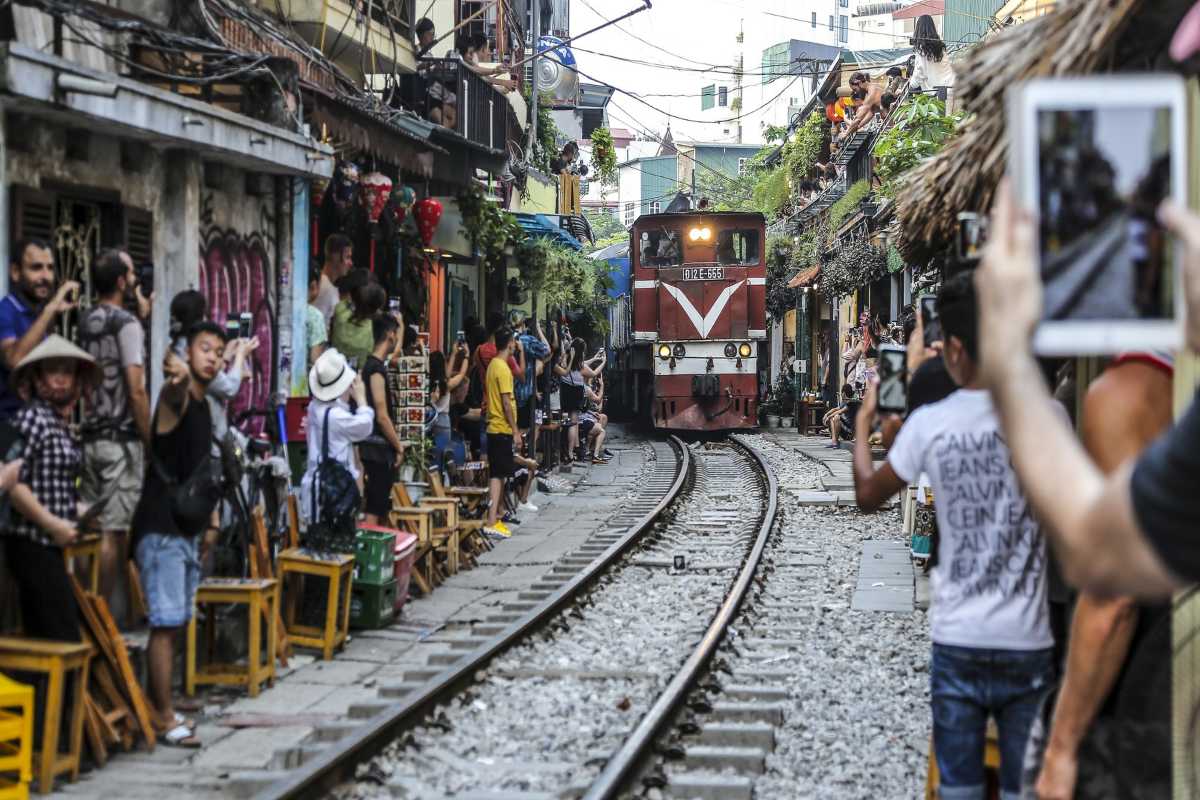
Responsible Interactions with Locals & Their Homes
Visiting Hanoi Train Street means stepping into a vibrant community where people live and work right alongside the tracks. Practicing responsible tourism Hanoi is essential to preserve the neighborhood’s authenticity and respect the daily lives of its residents.
Follow these guidelines to ensure your visit is ethical and considerate:
- Avoid intruding into private homes or peering through windows.
- Keep noise levels low to maintain the peaceful atmosphere.
- Respect personal boundaries and avoid blocking pathways.
- Support local vendors by purchasing food, drinks, or souvenirs.
- Be mindful of your impact and leave no litter behind.
Engaging respectfully with the locals enriches your experience and helps sustain the delicate balance between tourism and community life.
Travel thoughtfully and contribute positively to the unique spirit of Hanoi Train Street.

Navigating Recent Changes & Regulations at Hanoi Train Street
Stay updated on the current accessibility and official regulations of Hanoi Train Street to ensure a safe and compliant visit.
Visiting Hanoi Train Street in 2025 requires awareness of its evolving accessibility and visitor regulations. Due to safety concerns and community preservation efforts, rules and enforcement have changed, impacting how tourists can experience this unique attraction. To avoid surprises, it’s essential to verify the latest information before your visit.
Always check real-time updates from reliable sources and respect all guidelines to enjoy a safe and memorable visit to Hanoi Train Street.
Plan your visit carefully and stay informed to experience this iconic street responsibly.
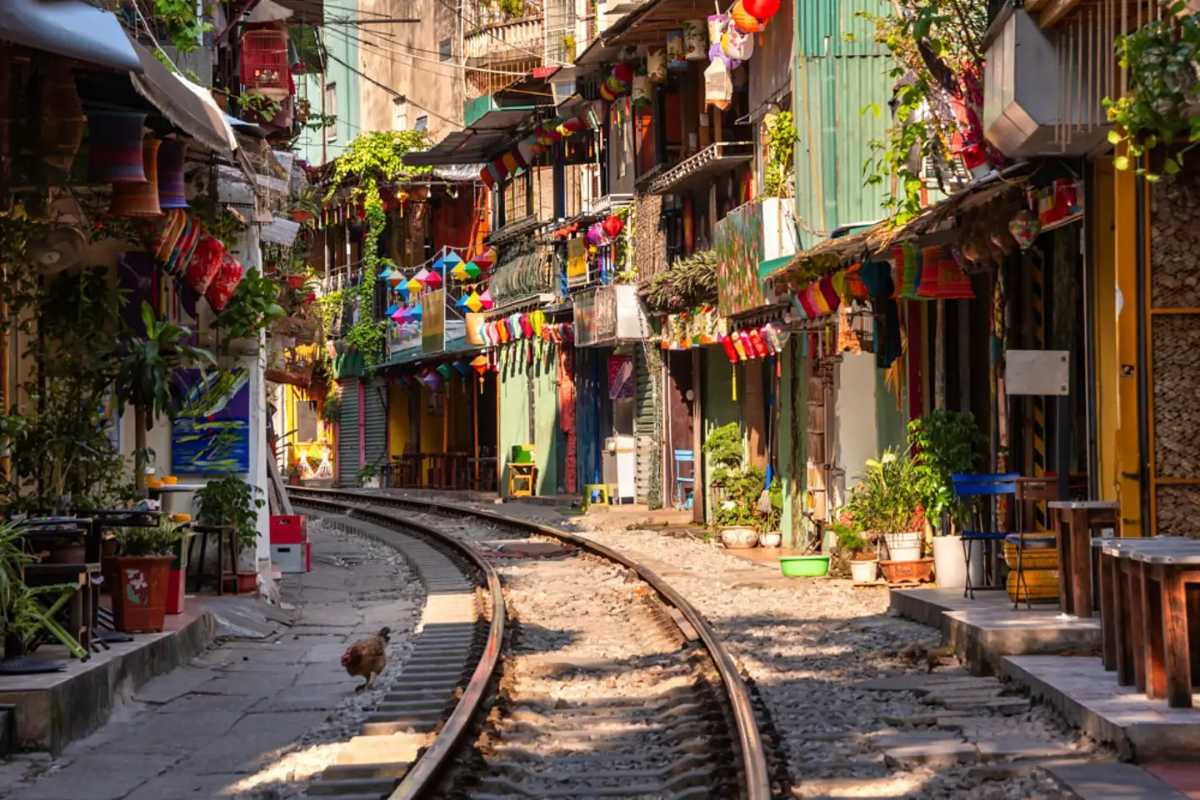
Current Status: Open or Closed? (Updates)
The accessibility of Hanoi Train Street changes based on safety assessments and local regulations. As of 2025, the street may be temporarily closed or have restricted access during certain hours or days to protect residents and ensure visitor safety.
If you wonder, Is Hanoi Train Street open in 2025?, the answer depends on official announcements from the Vietnam Railway Authority and Hoan Kiem District authorities. Restrictions may include limited visiting hours or controlled visitor numbers.
Stay alert to closure news and safety advisories by consulting local tourism boards or trusted guides before planning your trip.
Always verify Hanoi Train Street access restrictions to avoid inconvenience.
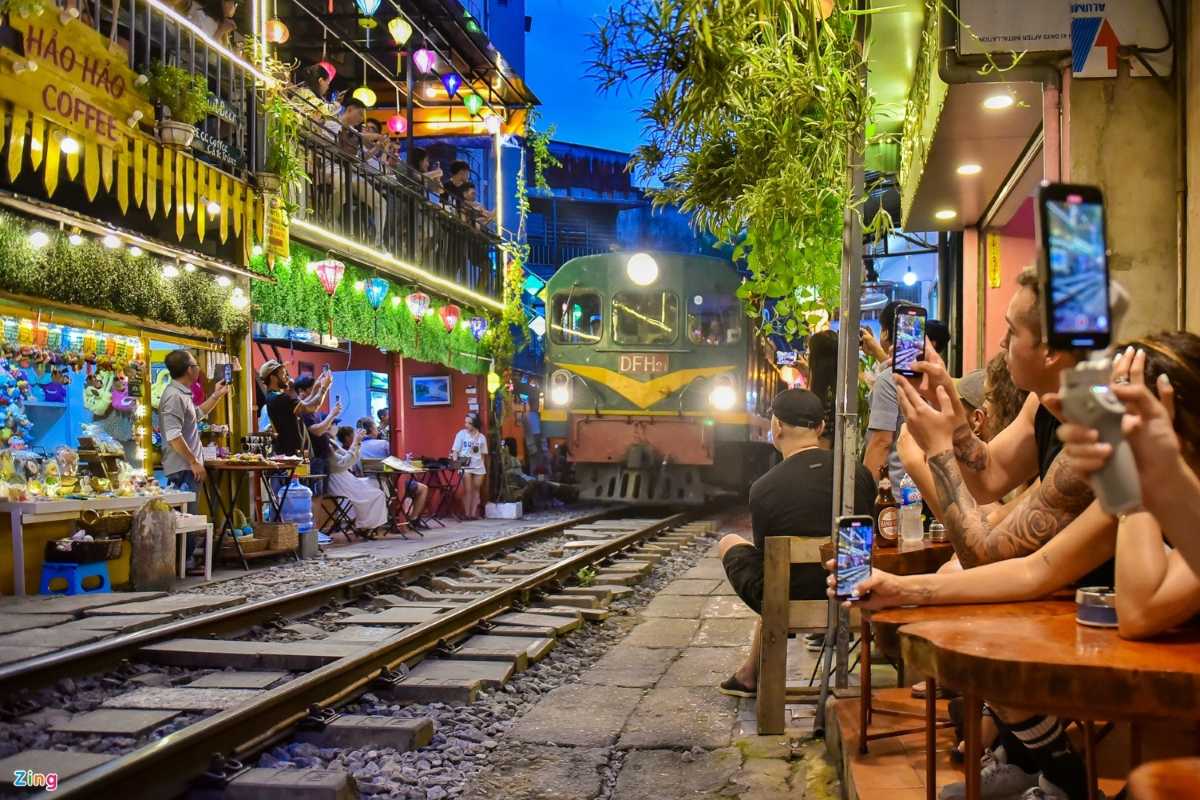
Understanding Official Regulations & Enforcement
Visitors to Hanoi Train Street must comply with specific rules designed to enhance safety and preserve community life. The Vietnam Railway Authority and Hoan Kiem District People's Committee have established guidelines addressing visitor behavior, restricted zones, and timing.
Key regulations include:
- Staying clear of tracks except during approved times.
- Following directions from local police and safety personnel.
- Avoiding obstruction of residential entrances and cafes.
- Prohibiting littering and loud disturbances.
The role of local authorities is critical in enforcing these rules to ensure a safe environment for both residents and tourists. Awareness of Hanoi Train Street safety rules and police enforcement helps visitors avoid penalties and enjoy the attraction responsibly.
Complying with these regulations is essential for a positive experience at Hanoi Train Street.
Laura's Encounter with Train Street Regulations
The narrow, vibrant lanes of Hanoi’s Old Quarter always promise a unique adventure, but my recent visit to Hanoi Train Street was an exercise in navigating not just the bustling crowds, but also the city's evolving rules. I'd heard whispers of stricter Hanoi Train Street regulations and wanted to experience it firsthand, not just as a tourist, but as someone trying to understand the delicate balance between local life and global fascination.
My initial approach felt like a covert operation. Instead of the wide-open access I'd seen in older travel videos, barricades now stood at key entry points along Trần Phú and Phùng Hưng streets. Uniformed police officers, polite but firm, stood guard, their presence a clear indicator of the new normal. My heart sank a little. Was this iconic spot now completely off-limits?
Just as I was about to turn away, a small, elderly woman emerged from behind one of the barriers, beckoning me with a smile. “Coffee? Train coming soon,” she whispered, her eyes twinkling. It became immediately clear: while direct access for casual wandering was restricted, the local café owners acted as your unofficial guides and sponsors. They’ve established a system, working with the authorities (primarily the Hoan Kiem District People's Committee and local police), to ensure visitor safety while still allowing their businesses to operate. This unwritten rule, a blend of official Vietnam Railway Authority regulations and local entrepreneurship, is key to experiencing the street now.
Inside her tiny cafe, the aroma of robust Vietnamese coffee and the faint sweetness of condensed milk enveloped me. I settled onto a low stool, feeling the familiar warmth of the city seep into me. The walls were adorned with whimsical train-themed art and faded photographs, testaments to years of visitors. The owner, sensing my curiosity, explained the current Hanoi Train Street safety rules. "Always listen to us," she emphasized, gesturing to the yellow line painted precariously close to the tracks. "When we say move, you move." Her tone was serious, underlining the inherent risks.
I watched as others arrived, some attempting to slip past the barricades only to be gently but firmly turned back by the police or redirected by the vigilant cafe owners. This direct Hanoi Train Street police enforcement is a constant presence, especially during scheduled train times. It's a clear effort to mitigate risks after past incidents where tourists, too engrossed in selfies, came dangerously close to the speeding locomotives. The lessons are harsh but simple: this is an active railway, not just a photo op.
The train’s approach was signaled by a series of long, piercing horn blasts, followed by the familiar rumble that grew into a crescendo. The café owner, without a word, began to pull in her stools and tables with surprising speed. I instinctively pressed myself against the weathered wall, feeling the cool, rough texture of the brick against my back. The very air vibrated, the sound deafening as the train thundered past, a blur of metal and raw power just inches from where I stood. It was exhilarating, a fleeting moment of controlled chaos.
One crucial piece of actionable advice I gleaned from this encounter is to always arrive at a café at least 30-45 minutes before the expected train time. Not only does it allow you to secure a good spot, but it also provides ample time to understand the local flow and listen to the Hanoi Train Street visitor guidelines from the cafe owners. They are your best resource for knowing the current train schedule and, more importantly, for understanding the specific safety protocols for their section of the tracks. Don't be afraid to ask questions; they are usually keen to help.
The enforcement, while a little jarring at first, ultimately reinforces the necessity of railway safety. It’s a testament to the fact that while the charm of Train Street is undeniable, the lives and livelihoods of those who call it home, and the safety of all, must come first. My personal experience navigating these Hanoi Train Street regulations taught me that respect for local authorities and businesses is paramount. By adhering to their advice and supporting their livelihoods by purchasing a drink or snack, you're not just buying a view of a train; you're contributing to the sustainable future of this truly unique and captivating corner of Hanoi.
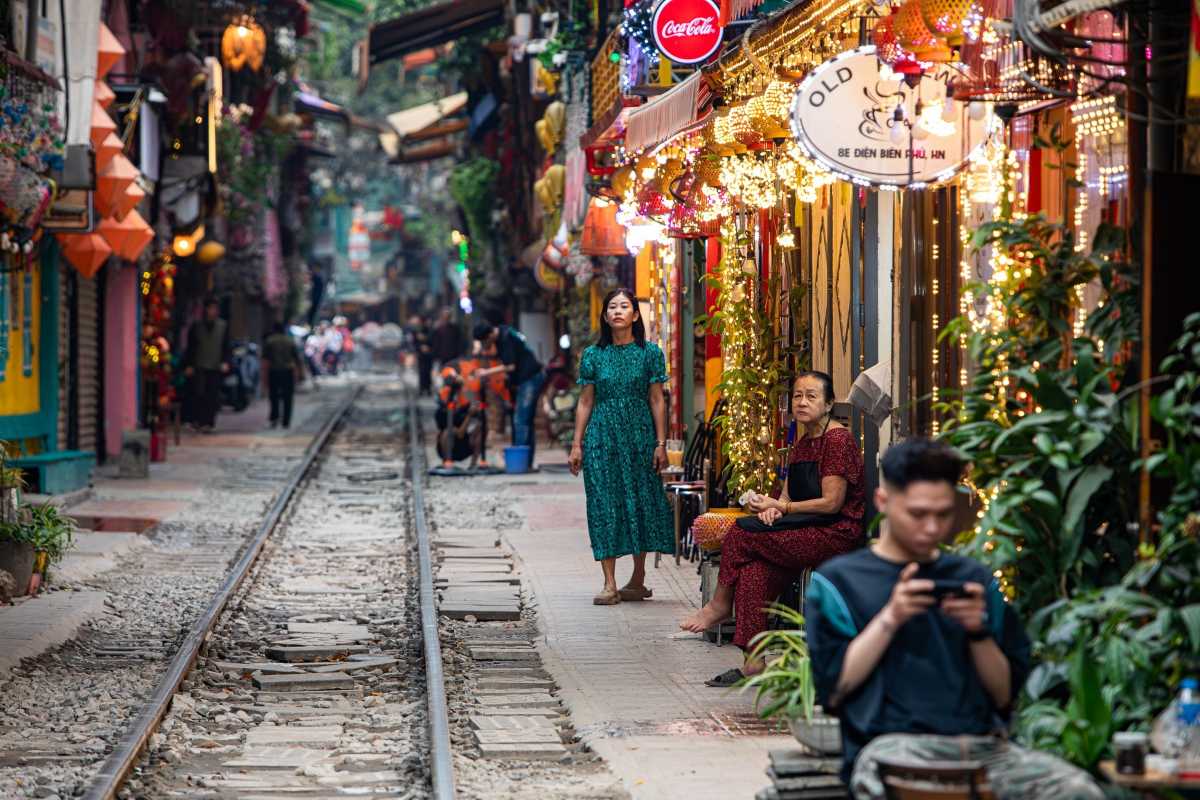
How to Verify Real-time Information (Local Sources, Official Announcements)
Because conditions at Hanoi Train Street can change rapidly, accessing reliable real-time information is crucial. Official announcements from the Hanoi Department of Tourism or the Vietnam Railway Authority provide authoritative updates.
Consult your hotel staff or trusted local guides who often have the latest news on Hanoi Train Street’s open status and visitor guidelines. Checking reputable travel websites and local news outlets also helps you stay informed.
Using multiple trusted sources ensures you receive accurate real-time updates and can plan your visit safely and confidently.
Stay proactive by verifying official announcements before and during your trip to Hanoi Train Street.
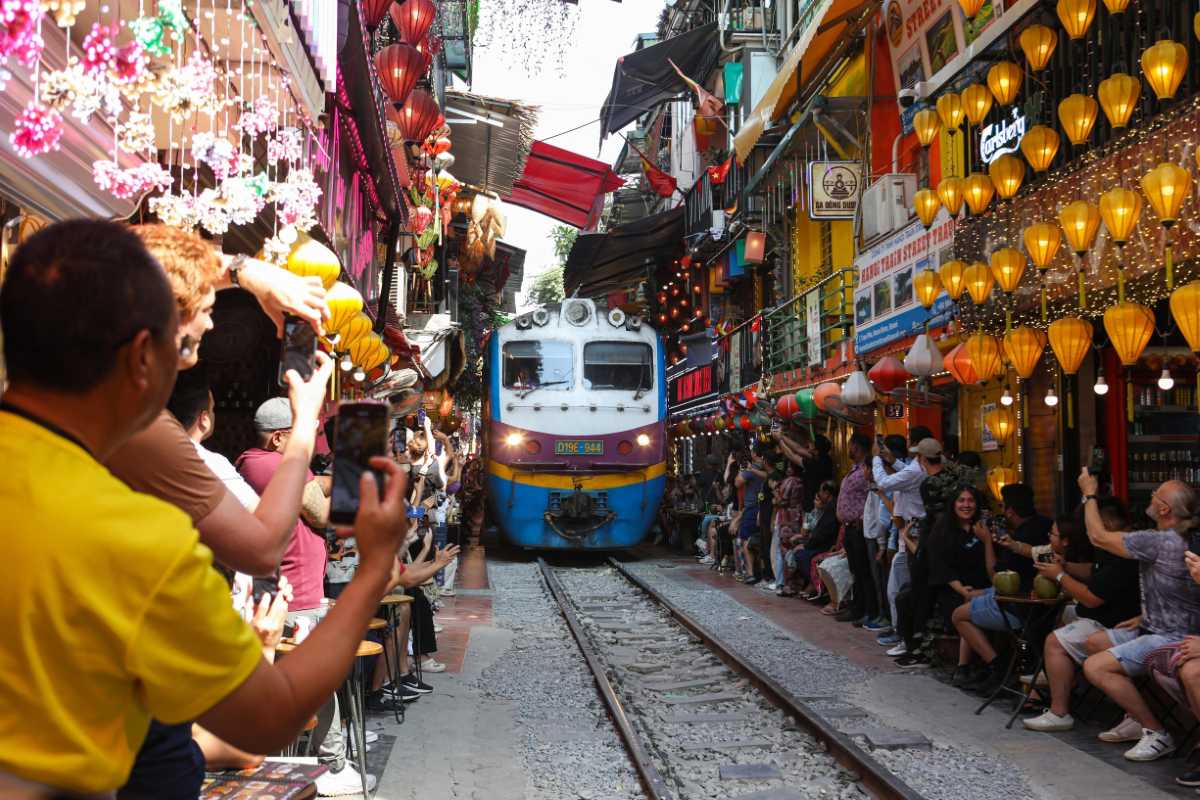
Beyond the Tracks: Immersive Local Experiences Around Train Street
Beyond the bustling activity of Hanoi Train Street, there lies a world of quieter, more authentic experiences waiting to be discovered. Exploring these areas lets you dive deeper into the daily rhythms and rich culture of the neighborhood, away from the main tourist crowds.
Venture into the peaceful side streets and alleys nearby to uncover quiet alleys Hanoi where traditional shops and friendly locals offer a glimpse into genuine urban life. Sampling street snacks and admiring local crafts adds layers of meaning to your visit.
Allow yourself to explore beyond the tracks and embrace the vibrant local culture surrounding Hanoi Train Street.
Plan your journey to include these immersive spots for a richer travel experience.
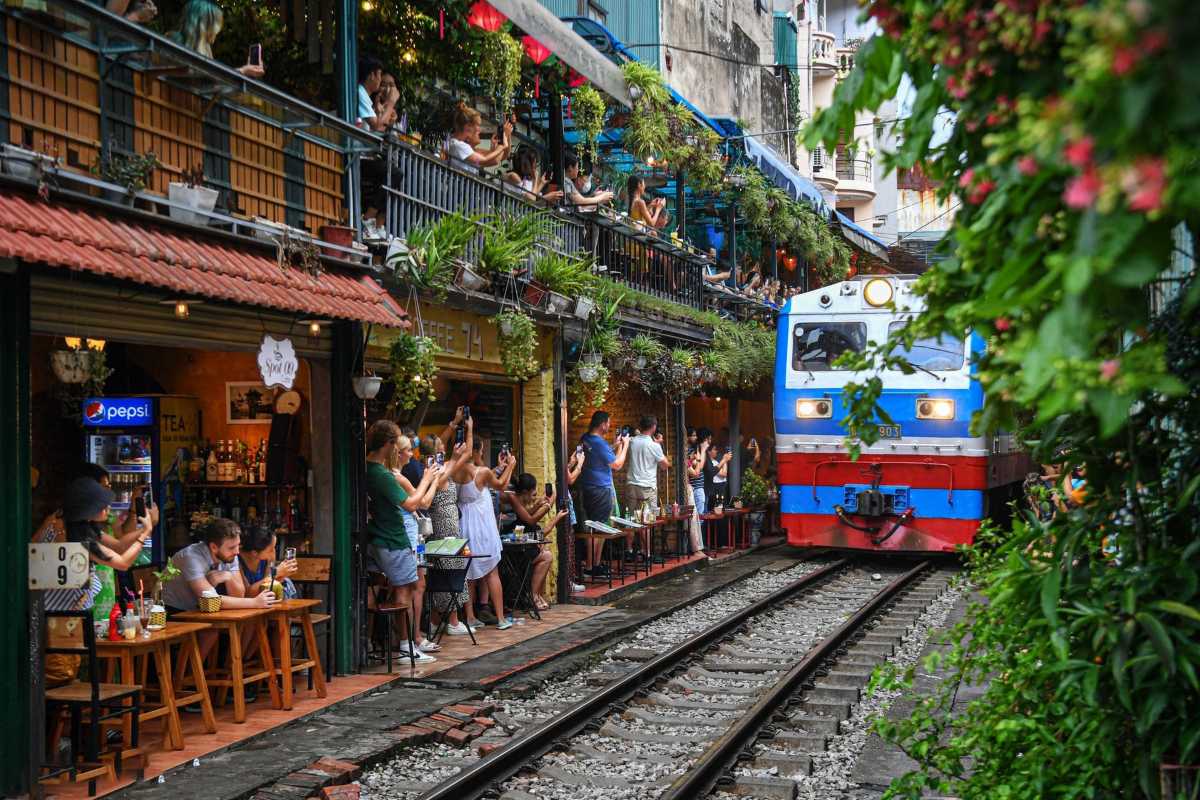
Hidden Gems: Exploring Ngõ 224 Lê Duẩn
Tucked just off the main attraction is Ngõ 224 Lê Duẩn, a tranquil alley that reveals a side of Hanoi less touched by tourism. Here, the pace slows and authentic local life thrives among traditional residences and small, family-run shops.
This quiet alleys Hanoi spot offers the perfect escape for those seeking genuine cultural encounters. As you stroll through, notice handcrafted goods and sample local street snacks prepared with time-honored recipes.
The charm of Ngõ 224 Lê Duẩn lies in its unspoiled atmosphere, inviting you to pause and experience Hanoi’s true heart.
Discover these peaceful corners near Hanoi Train Street to enrich your visit with cultural depth.
Mark's Discovery: A Quiet Morning in Ngõ 224
The Hanoi I knew was a symphony of scooters and street vendors, a beautiful, chaotic dance that rarely paused for breath. But on this particular morning, guided by a whispered tip from a local artist, I sought a different melody. My destination: Ngõ 224, an alley often overlooked in the rush to see the more famous stretches of Train Street. I was on a quest for a glimpse into local life Hanoi, hoping to find a pocket of tranquility amidst the urban hum.
Stepping into Ngõ 224 felt like passing through an invisible curtain. The sounds of the main road faded, replaced by the gentle clinking of teacups and the soft murmur of conversation. The air, usually thick with exhaust fumes, here carried the faint, sweet scent of jasmine and the earthy aroma of brewing coffee. It was a revelation – one of those rare, delightful moments when you feel you've stumbled upon a secret, a quiet alleys Hanoi had kept hidden just for me.
The alley itself was impossibly narrow, the buildings leaning in conspiratorially, their faded pastel facades softened by the morning light. Potted plants spilled over railings, creating miniature hanging gardens. Laundry, a vibrant tapestry of colors, swayed gently in the breeze. I noticed a small, unassuming café, barely more than a hole in the wall, with a few low plastic stools spilling onto the pavement. A woman with kind eyes and a welcoming smile gestured for me to sit.
I ordered a cà phê đen nóng (hot black coffee), the strong, dark brew arriving in a traditional phin filter, slowly dripping into the glass below. The warmth of the ceramic cup in my hands was comforting, a simple pleasure in this unexpected haven. I watched, mesmerized, as the coffee steadily brewed, its rich, roasted aroma filling the air around me. This wasn't about the train; it was about the profound stillness, the unhurried pace of life unfolding before me.
A grandmother meticulously swept the path in front of her doorway, her broom making soft, rhythmic swishes. Children, still in their pajamas, chased a scruffy dog down the alley, their giggles echoing off the walls. A man meticulously watered his bonsai tree, his movements slow and deliberate. There was no hurried rush, no anxious anticipation of an approaching train. This was genuine everyday life, lived out loud, yet with an intimate quietude.
I felt a deep sense of connection, an understanding that went beyond mere observation. This was the true heartbeat of Hanoi, often obscured by its more famous attractions. The light, filtering through the clotheslines and potted plants, dappled the ground in intricate patterns, constantly shifting. The occasional distant clang of metal reminded me that the railway was still there, but here, it was a backdrop, not the main event.
My personal discovery in Ngõ 224 wasn't just a place; it was a feeling. It was the joy of witnessing life unvarnished, the simple beauty of ordinary moments. It was the realization that true travel experiences aren't always about grand monuments or thrilling adventures, but often found in the quiet corners, in the shared humanity of everyday existence. This alley, with its gentle rhythm and genuine charm, offered a profound contrast to the bustling city outside. It solidified my belief that sometimes, the most memorable parts of a journey are discovered when you step off the well-worn path and simply allow yourself to be present in the subtle beauty of a place. Ngõ 224 provided an unforgettable glimpse into the authentic local life Hanoi holds, a quiet morning that resonated deeply within me.

Local Arts & Crafts: Workshops and Artisans Nearby
The area surrounding Hanoi Train Street is home to vibrant workshops and artisans dedicated to preserving Vietnamese crafts Hanoi. These spaces offer visitors the chance to observe traditional craftsmanship firsthand and support local talent by purchasing authentic, handmade souvenirs.
You can find:
- Lacquerware workshops showcasing intricate techniques.
- Silk weaving studios producing delicate textiles.
- Ceramic artisans crafting unique pottery pieces.
- Wood carving shops with finely detailed creations.
Supporting these local artisans Hanoi helps sustain cultural heritage and promotes ethical tourism. Visiting these workshops enriches your understanding of Vietnam’s rich artisan traditions.
Explore the nearby craft community to bring home meaningful memories from Hanoi Train Street.
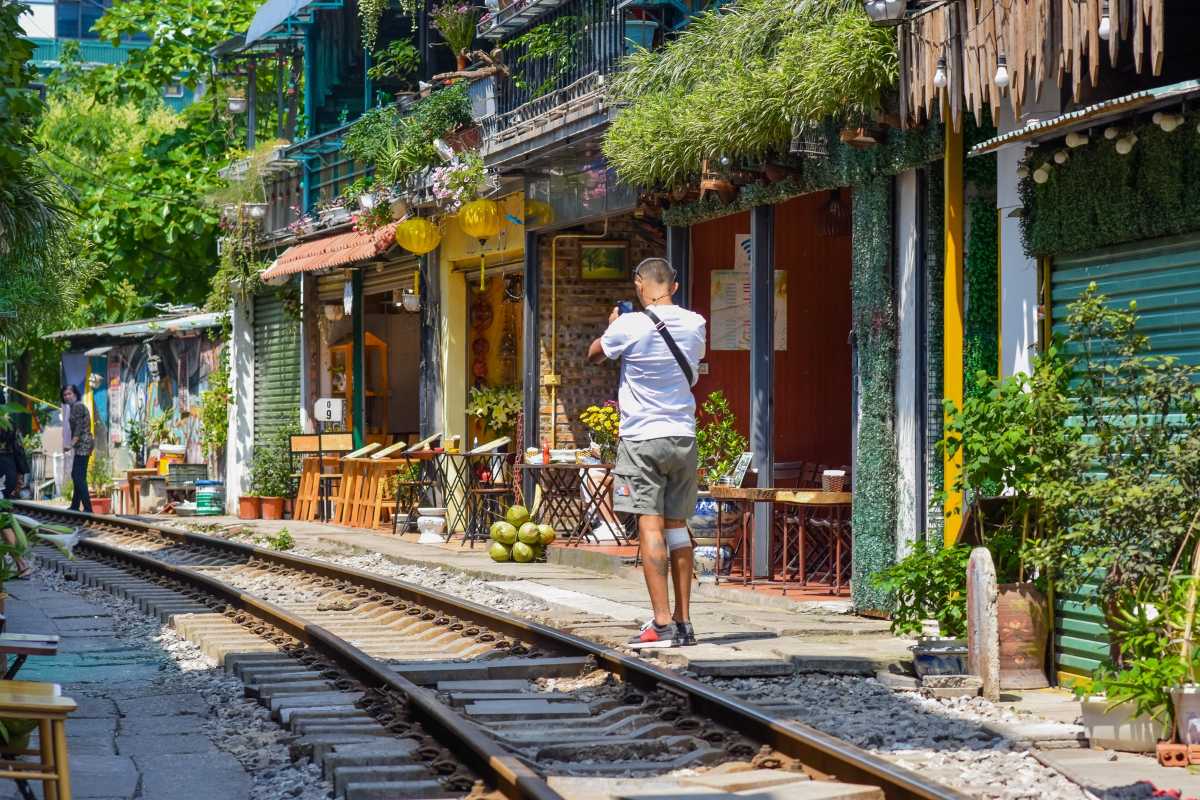
Connecting with Local Life: Beyond the Tourist Gaze
To truly appreciate Hanoi Train Street, step beyond the usual tourist routes and engage respectfully with the vibrant local life Hanoi. Observing daily activities and trying street food from non-cafe vendors offers an authentic connection to the neighborhood’s culture.
Tips for respectful engagement include:
- Watching local routines without intruding.
- Sampling street snacks Hanoi from family-run stalls.
- Using simple greetings and showing curiosity without overwhelming residents.
- Maintaining a low profile to preserve the atmosphere.
This mindful approach allows you to experience the heart of Hanoi and its welcoming community genuinely.
By embracing local rhythms, your visit to Hanoi Train Street becomes more meaningful and respectful.
Sarah's Cafe Chat: A Glimpse into Local Lives
The scent of brewing coffee always feels like an invitation in Hanoi, a promise of warmth and connection. On this particular afternoon, after navigating the bewildering, beautiful chaos of the Old Quarter, I found myself drawn to a tiny café tucked just off the train tracks, a place where the rhythmic distant clang of metal seemed to serve as the city’s heartbeat. My goal wasn't just to witness the famous train, but to truly immerse myself, to find genuine local interactions Hanoi is so famous for, beyond the usual tourist-vendor exchanges.
I chose a stool outside, a miniature plastic perch that somehow felt perfectly comfortable. The café owner, a woman in her late fifties with a wonderfully expressive face, greeted me with a nod and a gentle smile. Her name, I soon learned, was Linh. I ordered a cà phê sữa đá, and as she expertly prepared it, pouring the condensed milk first, then the strong, dark brew over ice, I began to chat. My Vietnamese is rudimentary at best, a clumsy collection of polite phrases, but Linh’s English, though limited, was infused with an eagerness to connect.
The conversation started slowly, a dance of gestures and broken sentences. I asked about the café, about how long she'd been here. She gestured to the surrounding houses, explaining that her family had lived on this street for generations. Her eyes crinkled at the corners as she recounted memories of her childhood, playing on the very tracks that now drew curious visitors from around the world. There was a quiet pride in her voice, a sense of belonging that resonated deeply.
As the afternoon wore on, a few other locals joined us. An elderly man, Linh’s neighbor, settled onto a stool nearby, sipping his tea and occasionally offering a gruff, good-natured comment. A young woman, Linh’s niece, popped in, fresh from school, and with her better English, the conversation flowed more freely. We talked about daily life, the challenges of rising living costs, and their hopes for the future. They asked about my home, my family, genuine curiosity shining in their eyes. It wasn’t a transactional conversation; it was a sharing of lives, a brief, beautiful confluence of worlds.
I learned about the careful choreography of life on Train Street: how they instantly clear their outdoor spaces when the train’s horn sounds, how the children are taught from a young age to respect the tracks, how the arrival of tourists has brought both opportunities and new considerations for safety. Linh spoke of the Hanoi Train Street regulations with a practical understanding, seeing them as necessary for the harmony of their community. There was no resentment, just an acceptance of change and adaptation.
What struck me most was their warmth, their unpretentious hospitality. They weren’t trying to sell me anything beyond a cup of coffee. They were simply sharing their space, their stories, and their lives. The rich, sweet taste of the cà phê sữa đá became intertwined with the feeling of genuine connection, each sip a reminder of the generosity of spirit I was encountering.
As the sun began to dip, casting long shadows down the narrow alley, the distant rumble of the evening train began. With practiced ease, Linh and her neighbor swiftly moved the stools and tables, creating a clear path. The moment the train roared past, a thunderous, exhilarating blur, we all instinctively leaned back, a shared experience of awe and slight trepidation. And then, just as quickly, normalcy resumed, the stools replaced, the conversation picking up right where it left off, a testament to their resilience and adaptability.
My chat with Linh and her neighbors wasn't just a glimpse; it was a deep dive into the heart of local Hanoi. It reinforced my belief that the true magic of travel lies not just in seeing famous sights, but in these organic, intimate local interactions Hanoi offers so generously. It’s in these shared moments over a simple cup of coffee that you truly understand a place and its people, creating memories that linger long after the train has passed.

Activities and Attractions Nearby
Extend your visit beyond Hanoi Train Street to discover the rich cultural, culinary, and entertainment options nearby. This vibrant area offers historic sites, bustling markets, and lively nightlife that together create a full Hanoi experience.
Whether you want to explore ancient landmarks, savor local street food, or enjoy a comfortable stay, the surroundings of Hanoi Train Street provide abundant opportunities for every traveler. Planning your itinerary to include these highlights will make your trip more memorable.
Take advantage of these nearby attractions to enrich your journey in Hanoi.
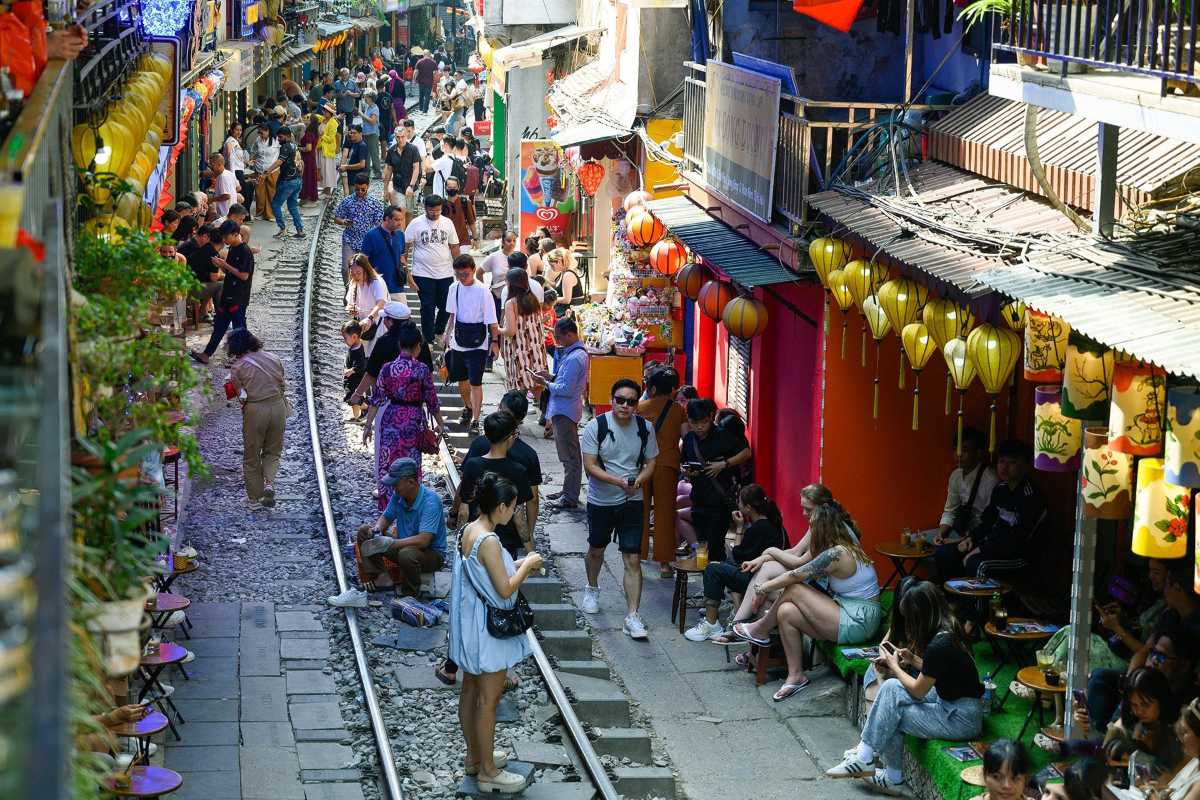
Exploring Hanoi Old Quarter
The Hanoi Old Quarter lies just a short walk from Hanoi Train Street and is a treasure trove of history and culture. This district is characterized by narrow streets lined with centuries-old architecture and vibrant local life.
Key landmarks include Hoan Kiem Lake, a serene urban oasis; Ngoc Son Temple, perched on a small island; and St. Joseph’s Cathedral, a stunning example of neo-gothic architecture. Each site offers insight into Hanoi’s rich heritage.
Exploring the Hanoi Old Quarter complements your visit to the train street by immersing you in the city’s historical and cultural fabric.
Key Landmarks and Historic Sites
Discover these must-see attractions near Hanoi Train Street:
- Hoan Kiem Lake: A peaceful lake at the heart of Hanoi, ideal for walks and relaxation.
- Ngoc Son Temple: Located on an island in Hoan Kiem Lake, known for its spiritual significance.
- St. Joseph’s Cathedral: A beautiful colonial-era cathedral featuring neo-gothic design.
Each site offers a unique glimpse into Hanoi’s history and culture, perfect for enriching your itinerary.
Including these landmarks adds depth to your Hanoi experience.
Markets and Shopping Opportunities
For a true taste of local commerce, visit Dong Xuan Market and nearby guild streets. Here’s how to make the most of your shopping:
- Bargain respectfully to get fair prices on souvenirs and goods.
- Explore specialized streets focusing on items like silk, ceramics, or spices.
- Look out for unique handcrafted items to support local artisans.
These markets provide an exciting shopping experience close to Hanoi Train Street.

Cultural Experiences
Immersing yourself in the rich culture near Hanoi Train Street adds a memorable dimension to your visit. The area offers vibrant traditional performances and festivals that showcase Vietnam’s heritage.
One highlight is the renowned water puppet theater Hanoi, where ancient stories come to life through skilled puppetry on water. Attending such performances brings history and folklore vividly to your experience.
Additionally, Hanoi’s traditional festivals Hanoi provide unique opportunities to witness local customs and celebrations. Planning your trip to coincide with these events can deepen your cultural connection.
Discovering these cultural experiences enhances your journey and offers lasting impressions beyond the train street.
Water Puppet Theater Performances
Experience authentic Vietnamese culture by attending water puppet shows near Hanoi Train Street. Popular venues include the Thang Long Water Puppet Theater, known for its vibrant performances and skilled puppeteers.
Booking tickets in advance is recommended, especially during peak tourist seasons, to secure the best seats. Shows typically last around an hour and are suitable for all ages.
Enjoy this enchanting art form that reflects the stories and traditions of Vietnam.
Traditional Festivals and Events
Hanoi hosts numerous festivals throughout the year that often coincide with visits to Hanoi Train Street. Important events include the Tet Lunar New Year, Mid-Autumn Festival, and various temple celebrations.
These festivals feature colorful parades, traditional music, and local rituals, offering vibrant cultural displays. Planning your trip to align with these occasions provides a deeper insight into Vietnamese traditions.
Attending such festivals enriches your travel experience with unique sights and sounds.
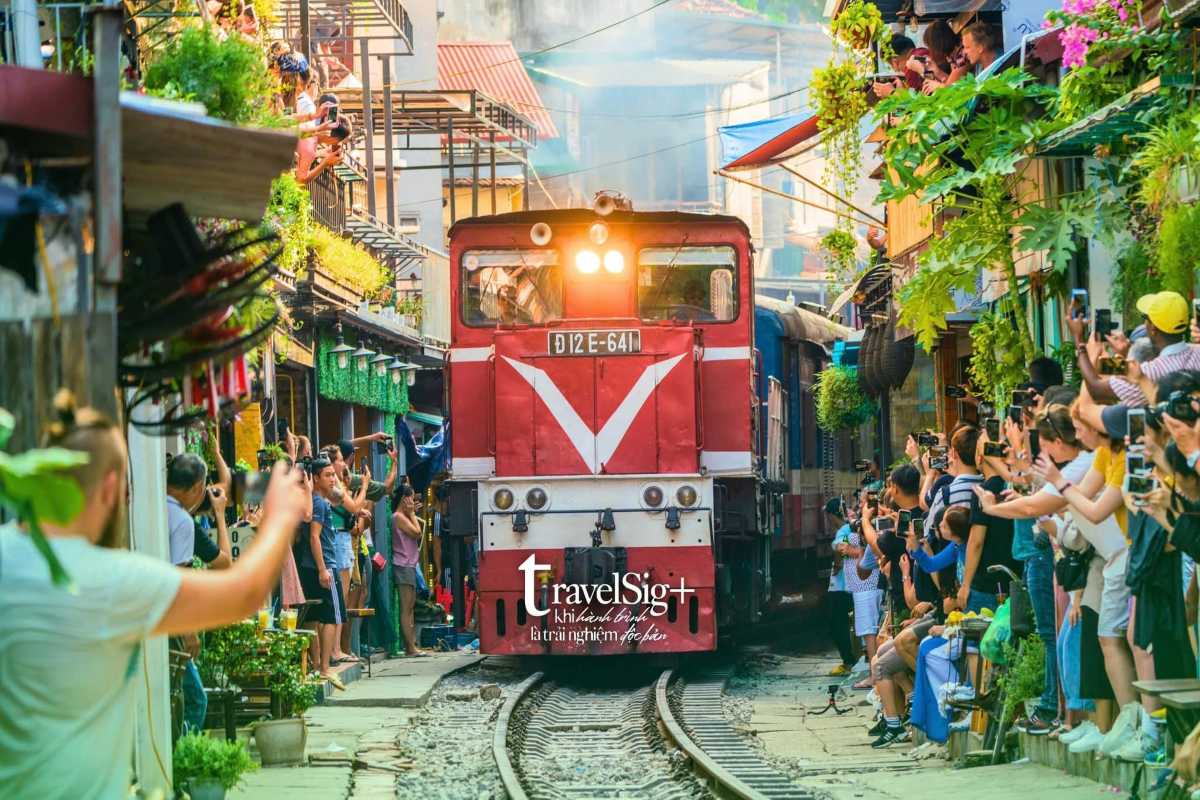
Food and Culinary Adventures
Exploring the food scene near Hanoi Train Street offers a delicious way to experience local culture. The area boasts an array of street food Hanoi vendors serving authentic dishes that capture the heart of Vietnamese cuisine.
From savory snacks to refreshing beverages like Vietnamese coffee, the culinary offerings invite you to indulge safely and enjoy new flavors. Knowing where to find the best bites helps maximize your taste adventure.
Savoring these local foods enriches your visit with genuine and memorable dining experiences.
Street Food Hotspots Near Train Street
Near Hanoi Train Street, several street vendors are celebrated for their tasty, authentic fare. Popular spots include stalls serving bánh mì sandwiches, pho noodle soup, and grilled skewers.
These vendors often specialize in signature dishes prepared fresh, offering affordable and flavorful meals. Visiting these hotspots allows you to sample diverse flavors and enjoy the vibrant street food culture.
Include these stops on your itinerary to savor the best street food Hanoi has to offer.
Recommended Local Dishes to Try
Expand your culinary experience by trying a variety of Vietnamese dishes near Hanoi Train Street:
- Pho: Vietnam’s famous noodle soup with rich broth and fresh herbs.
- Banh Cuon: Steamed rice rolls filled with savory pork and mushrooms.
- Bun Cha: Grilled pork served with noodles and dipping sauce.
- Vietnamese Coffee: Strong and sweet, often served iced.
These dishes highlight the diversity and richness of local cuisine, making your visit even more flavorful.
Enjoy tasting these specialties to truly appreciate Hanoi’s food culture.
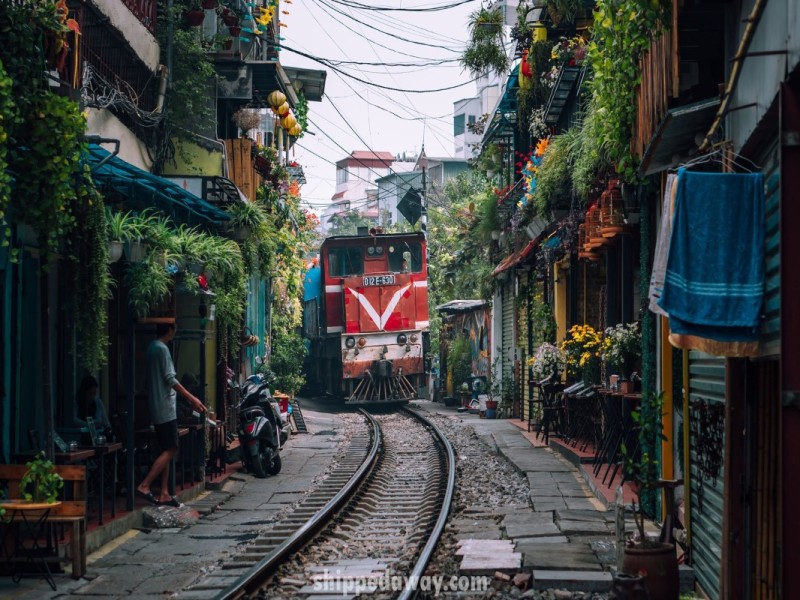
Nightlife & Evening Experiences Near Train Street
As the sun sets near Hanoi Train Street, the area transforms with lively nightlife options perfect for relaxing after a day of exploration. From casual bia hoi spots serving fresh local beer to rooftop bars offering panoramic city views, there is something for everyone.
Many venues feature live music, creating a vibrant atmosphere where you can mingle with locals and fellow travelers. Most places close around midnight, making evenings both exciting and manageable.
Enjoying the nightlife nearby offers a refreshing end to your day near Hanoi Train Street.

Accommodation Options Close to Hanoi Train Street
Finding the right place to stay near Hanoi Train Street ensures convenience and comfort throughout your visit. Options range from luxury hotels to budget-friendly hostels and charming guesthouses.
Whether you prioritize modern amenities or authentic local charm, the area has accommodations suited to every traveler’s needs.
Consider booking early during peak seasons to secure the best rates and availability.
Hotels, Hostels, and Guesthouses
Here is a breakdown of lodging near Hanoi Train Street:
- Luxury Hotels: High-end properties offering top amenities and services.
- Mid-Range Hotels: Comfortable stays with good value and convenient locations.
- Budget Hostels: Affordable options ideal for solo travelers and backpackers.
- Guesthouses: Small, family-run places providing local hospitality.
Choosing the right accommodation lets you enjoy the area with ease and peace of mind.
Booking Tips for Peak Seasons
To avoid last-minute stress when visiting Hanoi Train Street:
- Book accommodations several months in advance during holidays and festivals.
- Use reliable booking platforms with transparent reviews.
- Consider flexible cancellation policies for peace of mind.
- Contact hotels directly for possible special deals or advice.
Early planning helps secure your preferred stay and ensures a smooth trip.

Safety, Sustainability, and Community Impact
Visiting Hanoi Train Street requires awareness of safety protocols and respect for the local community. This section highlights essential guidelines to ensure a secure and responsible visit while appreciating the efforts to preserve the environment and culture surrounding the attraction.
Understanding visitor safety measures and the impact of tourism helps foster a positive relationship between travelers and residents. Being informed empowers you to enjoy the experience thoughtfully and sustainably.
Prioritize safety and respect to contribute to the ongoing vitality of Hanoi Train Street.

Safety Measures for Visitors
To ensure a safe visit to Hanoi Train Street, be aware of official regulations and practical safety tips. Following these guidelines protects you and respects the local community’s well-being.
Key points include:
- Always stay behind designated safety lines during train passings.
- Follow instructions from local authorities and residents.
- Avoid stepping onto the tracks or obstructing the train’s path.
- Keep a close eye on children and personal belongings.
Being prepared helps you enjoy the attraction safely and responsibly.
Official Regulations and Visitor Guidelines
Visitors must adhere to the following rules:
- No crossing the tracks except at authorized times and locations.
- Respect private property and avoid entering residential areas.
- Follow all signage and verbal warnings from officials.
- Maintain orderly behavior to prevent accidents or disturbances.
Understanding and complying with these regulations ensures everyone’s safety and preserves the unique charm of Hanoi Train Street.
Personal Safety Tips During Train Passings
Stay vigilant with these tips:
- Listen carefully for train signals and approach times.
- Move back promptly when the train approaches.
- Avoid distractions like loud music or phone use near tracks.
- Wear comfortable shoes for navigating uneven surfaces safely.
Your attentiveness helps maintain a safe environment for all visitors and residents.

Environmental and Cultural Preservation Efforts
Efforts to preserve the environment and culture around Hanoi Train Street are vital to maintaining its charm and sustainability. Both the local community and authorities work diligently to balance tourism with conservation.
These initiatives focus on reducing environmental impact while respecting the cultural fabric of the neighborhood. Visitors benefit from a cleaner, safer space that honors the unique heritage of the area.
Understanding these preservation efforts encourages responsible tourism that supports the longevity of Hanoi Train Street.
Local Community Responses to Tourism
The residents near Hanoi Train Street have adapted their lives to the influx of tourists with a spirit of resilience and hospitality. Many have embraced small-scale businesses, offering local crafts and refreshments while maintaining their traditions.
Community-led initiatives promote respectful tourism practices and encourage visitors to engage thoughtfully with the neighborhood. This blend of adaptation and preservation reflects the strong bond between the locals and their environment.
Appreciating these community efforts enriches your visit and fosters meaningful connections.
Initiatives to Maintain Cleanliness and Reduce Noise
Key actions to preserve the area include:
- Regular street clean-ups organized by local groups and authorities.
- Designated waste disposal points to minimize littering.
- Noise control measures to respect residents’ peace.
- Visitor education campaigns promoting sustainable behavior.
These ongoing efforts help ensure Hanoi Train Street remains a vibrant yet respectful destination for all.

Responsible Tourism Practices
Practicing responsible tourism near Hanoi Train Street helps preserve the local culture and environment while supporting the community. Visitors can learn simple ways to minimize negative impacts and show respect through thoughtful actions.
By adopting ethical habits, you contribute to a sustainable and positive travel experience that benefits both residents and tourists alike. Embracing these practices makes your visit more meaningful and rewarding.
How Visitors Can Respect Local Residents
To maintain harmony with residents, keep these guidelines in mind:
- Keep noise levels low, especially near homes.
- Avoid entering private property or peering into windows.
- Be mindful of photography; ask permission before taking pictures of people.
- Dispose of trash properly and keep public spaces clean.
Respectful behavior helps preserve the community’s peaceful daily life and builds goodwill.
Supporting Local Businesses Ethically
When spending near Hanoi Train Street, choose to support genuine local shops by:
- Buying directly from family-owned cafes and vendors.
- Avoiding mass-produced souvenirs and opting for handcrafted items.
- Asking questions about products to show genuine interest.
- Being fair and polite during transactions to foster positive interactions.
Your conscious choices help sustain the local economy and encourage authentic cultural exchanges.

Additional Tips and Recommendations
To get the most out of your visit to Hanoi Train Street, it helps to plan carefully and take advantage of insider tips. This section offers practical advice, suggested itineraries, and useful preparations to enhance your experience and make your trip smooth and memorable.
Whether you want to combine visits with nearby attractions or save money with smart budgeting, these recommendations support a well-rounded and enjoyable adventure at Hanoi Train Street.

How to Make the Most of Your Visit
Maximize your time around Hanoi Train Street by planning a thoughtful itinerary. Combining this visit with other nearby sights offers a fuller glimpse of Hanoi’s rich culture and history.
Consider half-day or full-day options to fit your interests, whether you’re a photographer chasing perfect shots or a foodie eager to try local flavors.
Combining Hanoi Train Street with Other Nearby Attractions
Some great itinerary ideas include:
- Start with Hanoi Train Street for the unique train experience.
- Walk to Hoan Kiem Lake for scenic views and Ngoc Son Temple visit.
- Explore Hanoi Old Quarter for shopping and street food.
- Attend an evening Water Puppet Theater show nearby.
These combinations provide variety and showcase Hanoi’s vibrant culture.
Suggested Itineraries for Different Types of Travelers
Tailor your day based on your interests:
- Photography lovers: Visit Hanoi Train Street early morning, then capture sunset scenes at Hoan Kiem Lake.
- Food enthusiasts: Combine Train Street with street food tours in the Old Quarter.
- History buffs: Include visits to St. Joseph’s Cathedral and traditional markets.
Personalizing your plans makes the visit more rewarding and engaging.

Insider Advice and Lesser-Known Facts
To make your visit to Hanoi Train Street truly special, it helps to know some insider tips and lesser-known facts. These insights go beyond typical travel advice and help you experience the street in a unique and memorable way. Learning about off-peak hours and train schedule variations can enhance your visit and avoid common pitfalls.
Being informed allows you to enjoy the atmosphere more fully and create lasting memories at this iconic location.
Off-Peak Visiting Hours
For a quieter, more personal experience at Hanoi Train Street, consider these off-peak times:
- Early mornings before the main tourist rush.
- Late evenings when the crowds thin out but the ambiance remains lively.
- Weekdays generally see fewer visitors than weekends.
Visiting during these hours lets you appreciate the street’s charm with fewer distractions.
Seasonal Variations in Train Traffic
Train schedules at Hanoi Train Street can vary depending on the season and special events:
- Local holidays and festivals may affect the number and timing of trains.
- Winter months may have fewer train passages compared to busier seasons.
- Always check recent schedule updates before planning your visit.
Being aware of these changes helps you plan better and ensures you don’t miss the key moments.

Preparing for Your Visit
Getting ready for your time at Hanoi Train Street ensures comfort and a smooth experience. Knowing what to bring and how to communicate locally makes your visit more enjoyable and respectful. This section guides you through essential items and helpful Vietnamese phrases to prepare before you arrive.
What to Bring (e.g., Cash, Camera, Weather Gear)
For an optimal visit, pack these essentials:
- Small bills in Vietnamese Dong for purchases and tips.
- A reliable camera or smartphone to capture moments.
- Weather-appropriate clothing: light, breathable fabrics in summer; a jacket during cooler months.
- An umbrella or raincoat during the rainy season.
- Comfortable walking shoes for narrow paths.
- A power bank to keep devices charged.
Being prepared with these items will help you avoid common hassles and enjoy your visit fully.
Language Tips and Local Phrases for Interaction
Knowing basic Vietnamese phrases can enhance your interactions:
- “Xin chào” (Hello) – A polite greeting.
- “Cảm ơn” (Thank you) – Show appreciation.
- “Bao nhiêu tiền?” (How much?) – Useful when shopping or ordering.
- “Xin lỗi” (Excuse me/Sorry) – For polite interruptions or apologies.
- “Có thể giúp tôi không?” (Can you help me?) – Handy if you need assistance.
Using these phrases shows respect and often opens doors to warmer local connections.

Budgeting for Your Train Street Visit & Beyond
Visiting Hanoi Train Street doesn’t have to be expensive. Understanding typical costs and learning budgeting tips helps you enjoy the experience without overspending. This section provides practical advice on managing your finances so you can focus on what matters—immersing yourself in this unique destination.
Sophie's Budget Hacks: Experiencing Train Street on a Dime
Hanoi, for all its vibrant charm, can easily chip away at a budget if you're not careful. But I’m a firm believer that incredible travel experiences don't have to break the bank. My recent adventure to Hanoi Train Street was a prime example of putting my budget hacks to the test, proving that you can soak in the unique atmosphere and even witness the famous train without emptying your wallet.
My first mission was finding the sweet spot. Many of the cafes directly on the most popular sections of Train Street, while charming, often have slightly inflated prices for drinks, banking on their prime location. My strategy was simple: explore the periphery. I wandered a few of the narrower side alleys branching off the main thoroughfares near Trần Phú Street, deliberately looking for places that felt more local, less overtly tourist-focused.
I stumbled upon a humble spot just a block away, not directly on the tracks, but with a clear, unobstructed view down a short lane that led directly to the railway. It was a no-frills establishment: a few worn plastic tables, even lower stools, and a friendly, older woman stirring a pot of something fragrant. The air here smelled of strong coffee and subtle spices, a more authentic blend than the pure coffee aroma from the more central spots.
"Coffee?" she asked, with a welcoming smile. I pointed to the cà phê sữa đá sign, which was handwritten and delightfully smudged. The price, proudly displayed, was significantly lower than what I'd seen even a few minutes prior. This was my first win for Hanoi Train Street on a dime. I paid with a small denomination, feeling a rush of satisfaction. The iced coffee arrived, perfectly strong and sweet, precisely what I craved.
My key budget hack for Train Street is this: you don't need to be on the tracks to get the full experience. Many of the smaller, lesser-known cafes on the immediate side streets offer fantastic views and a more local vibe for a fraction of the cost. You might miss the sensation of the train inches from your nose, but you gain a broader perspective of the neighborhood life surrounding it, and your wallet will thank you.
While waiting for the train, I observed the scene. Locals went about their day: a man repaired a scooter, women chatted animatedly, children played hopscotch on the cracked pavement. This immersion into everyday local life Hanoi offered was priceless, far more valuable than any overpriced souvenir. I avoided buying snacks or additional drinks from the more prominent cafes unless absolutely necessary, opting instead for a street food snack I’d bought earlier from a vendor further afield. That's another tip: grab your snacks or water before you get to the immediate vicinity of the attraction. Prices always creep up closer to tourist hotspots.
When the train’s distant horn finally sounded, the cafe owner, with a practiced calm, began to clear her outdoor seating. Even though we weren’t directly on the tracks, the rumble grew quickly, vibrating through the ground. The train shot past, a blur of green and steel, the wind from its passage momentarily ruffling my hair. The experience was still exhilarating, the rush of adrenaline just as potent, despite my slightly more distant vantage point.
Another smart move for experiencing Train Street on a dime is to time your visit wisely. Mid-week, off-peak hours often mean fewer crowds, making it easier to find a prime, affordable spot without feeling rushed or pressured to buy more. Check a reliable local source for the train schedule Hanoi Train Street typically adheres to, then plan to arrive about 45 minutes before, giving you time to find your budget-friendly perch and settle in.
My final takeaway for budget travelers is simple: engage with the locals. My cheap coffee came with a side of warm smiles and a simple wave from the café owner. A brief, polite exchange can often unlock better prices or a more authentic experience than simply sticking to the well-trodden tourist paths. By employing these budget hacks, I enjoyed a truly memorable Train Street experience, immersing myself in the local rhythm without feeling the pinch, proving that authenticity and affordability can indeed go hand in hand in vibrant Hanoi.

Conclusion
As you reflect on the vibrant world of Hanoi Train Street, remember its unique charm lies not only in the trains that pass so closely but in the authentic community life that surrounds it. Visiting with respect and mindfulness ensures this special place remains a welcoming space for both locals and travelers. Let your journey here be one of discovery and genuine connection.

Summary of Key Points
Begin your understanding of Hanoi Train Street by revisiting its most distinctive features. This section recaps what makes this destination so special and important.
- Hanoi Train Street offers an unparalleled urban experience where everyday life and railway history intertwine.
- The close proximity of trains to homes and cafes creates a surreal and captivating atmosphere.
- Visitors should always follow safety guidelines to respect residents and stay secure.
- Exploring nearby cultural sites, local eateries, and hidden alleys enriches your visit.
- Supporting local businesses and practicing responsible tourism sustains the community’s vitality.
These highlights serve as your foundation for appreciating this unique attraction and planning a respectful visit.

Why You Should Experience Hanoi Train Street Yourself
If you’re wondering why Hanoi Train Street deserves a place on your travel list, this section explains the personal and cultural value it offers.
Experiencing Hanoi Train Street is more than witnessing a train passing—it’s about embracing a living story shaped by people, culture, and history. The sights, sounds, and rhythms create memories that stay with you long after you leave. Whether you’re a photographer, a culture lover, or a curious traveler, this unique destination promises moments that inspire and delight.
By visiting, you become part of its continuing story, making your trip truly unforgettable.

Share Your Hanoi Train Street Stories and Tips
Your voice matters in the growing community of travelers who cherish Hanoi Train Street. This section invites you to contribute and engage.
Sharing your experiences, advice, and favorite moments not only helps future visitors but also supports preserving the spirit of this vibrant place. Your stories foster connection, promote responsible travel, and celebrate the genuine local culture.
Join the conversation and help keep Hanoi Train Street alive for generations to come.
Mike Nguyen
Travel Advisor
Mobile: +84917506881 (whatsapp available)
Email: contact@asiatravellinks.com
Faqs
Hanoi Train Street is a unique urban attraction where an active railway track runs through a narrow residential neighborhood in Hanoi. It offers visitors an intimate view of trains passing just inches from homes, cafes, and shops, creating a surreal and vibrant street scene. This blend of local life and dynamic railway activity makes it a must-see destination for travelers.
The street is famous for its lively atmosphere, colorful houses, and close-knit community that adapts daily to the passing trains. Visitors experience an authentic slice of Hanoi life while witnessing a rare urban spectacle.
Plan your visit to Hanoi Train Street to immerse yourself in this distinctive cultural and sensory experience.
Getting to Hanoi Train Street from the Old Quarter is straightforward and convenient. The street is within walking distance, making it easy to explore on foot.
Follow these directions:
- Start from Hoan Kiem Lake, the heart of the Old Quarter.
- Walk northeast along Le Duan Street toward the railway tracks.
- Look for signs directing you to the train street or ask locals for “Hanoi Train Street.”
- The walk takes about 10–15 minutes, passing through bustling local markets and small shops.
Alternatively, use public buses or ride-hailing apps like Grab for a short, inexpensive ride if you prefer not to walk.
Walking lets you soak up the vibrant street life of the Old Quarter before reaching Hanoi Train Street, enhancing your overall visit.
Make sure to follow local advice and check current access conditions before you go.
Visiting Hanoi Train Street does not require an entry fee, making it accessible to all travelers interested in this unique urban spectacle.
However, keep in mind:
- Some cafes along the tracks may have minimum purchase requirements to enjoy their train views.
- Supporting these local businesses by ordering refreshments helps sustain the community.
- Always respect any signage or instructions related to visitor access to ensure safety.
The free access combined with vibrant local culture offers an authentic experience without additional cost.
Enjoy your visit while supporting the local economy through responsible spending.
The best time to visit Hanoi Train Street depends on both train schedules and seasonal weather to maximize your experience.
Consider these tips:
- Trains typically pass through the street twice daily, around 3:30 PM and 7:00 PM, with some variations.
- Arrive 20–30 minutes early to secure a good viewing spot.
- Weekdays generally have fewer tourists compared to weekends.
- The cooler months from October to April offer more comfortable weather with less humidity and rain.
- Avoid peak summer months if you prefer less heat and crowd.
Visiting during off-peak hours or seasons provides a quieter, more intimate atmosphere for photos and cultural immersion.
Plan your visit according to train schedules and weather forecasts to get the most from your time at Hanoi Train Street.





